

Driving Progress
A Decade of Civic Impact for New York's Asian American Communities
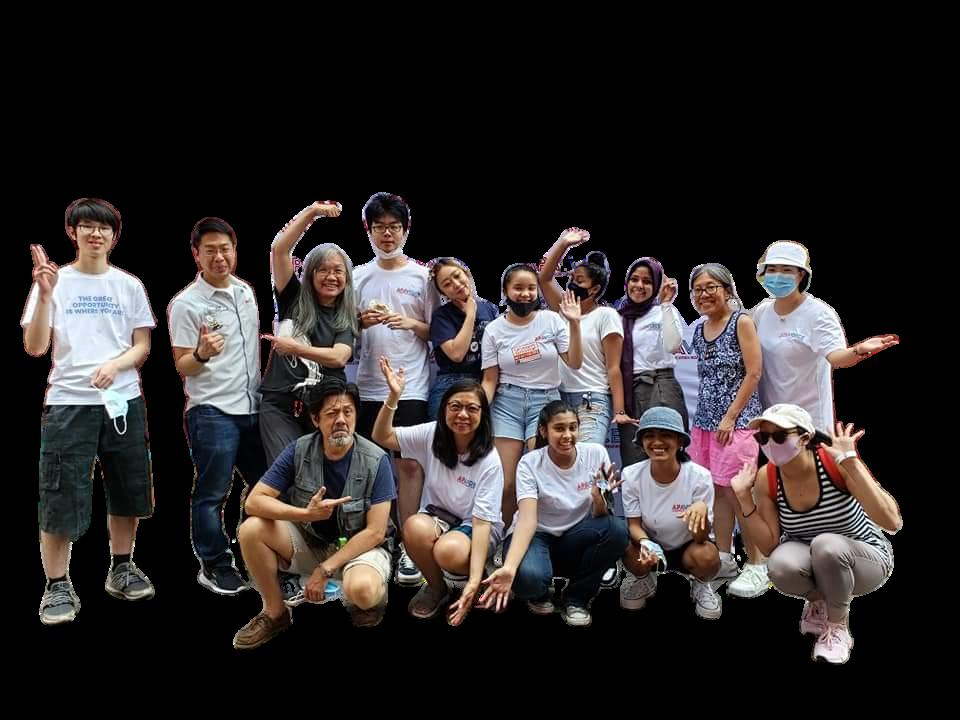
 A Letter from John Park Executive Director, MinKwon Center for Community Action Convener of the APA VOICE Coalition
A Letter from John Park Executive Director, MinKwon Center for Community Action Convener of the APA VOICE Coalition


On behalf of the MinKwon Center for Community Action and APA VOICE, we are excited to share with you this report which was been ten years in the making.
The MinKwon Center’s earliest origins are in a democracy movement in South Korea, led by the brilliant organizer and pro-democracy activist Yoon Han Bong. He believed our rights, dignities, and lives can be protected if we organize together. Established in Queens 40 years ago, MinKwon 민권 is the Korean word for civil rights.
Our Democracy work started with a citizenship and naturalization program and voter registration drives. However, the first iteration of what is now APA VOICE did not exist until the 2010 Redistricting Cycle. One of the first major outcomes of our coalition was the successful creation of NY-6 that later elected Congresswoman Grace Meng, the first Asian American US Congressional Representative on the East Coast
We achieved major successes in 2010. Still, we saw that at the time, only five Asian American organizations in New York had the capacity to engage civically at this level. We learned that the civic landscape was dire for the Asian-American community.
Prior to the formation of APA VOICE, Asian American organizations in New York did not have the tools or capacity to adequately engage Asian American voters
New York had historically been in the bottom 20% of all states in voter participation
Asian Americans have historically had the lowest voter participation for New York
Asian Americans are the fastest growing population at every level (Federal, State, and City)
Asian Americans are largely ignored by both major parties and receive the least amount of engagement, election information, and materials in language
APA VOICE was formally created in 2014 because it was needed. We are proud to share this report with you, not just because of the insights we learned from data trends of Asian American voters, but because APA VOICE and our members were on the ground, in the neighborhoods, doing the work that made those trends happen. We did this work because our voices matter.
Over the past decade, we have grown to be one of the most impactful civic coalitions on the East Coast. Our coalition reflects the geographic, linguistic, and ethnic diversity of New York’s Asian American communities. As we celebrate our first ten years, we know we must continue our commitment for another decade. Together, we can ensure that all voices are fairly represented.


Executive Summary

Asian Pacific Americans Voting and Organizing to Increase Civic Engagement (APA VOICE) marks its 10 year anniversary in 2024, and we see the importance of building an inclusive democracy more than ever before. In a post-2020 world, we are still dealing with the effects of public health and affordability crises, as well as a rise in anti-Asian hate and anti-immigrant sentiment. War and militarization abroad have only exacerbated attacks on our communities. These trends impact every aspect of our daily lives, from where we live to how we vote. At the same time, the number of Asian registered voters is growing, nearly doubling in the past decade. Asian American communities in New York are rebuilding, and need our support to do so.
APA VOICE is the first and foremost coalition in New York City dedicated to elevating civic participation among Asian Americans. Over the past decade, we have built the capacity of over 35 organizations and contacted over 200,000 voters each year.
MinKwon Center, as the convener of the coalition, brings two decades of grassroots civic engagement experience to empower each organization as leaders in their own communities.

As we celebrate 10 years of APA VOICE, this report reflects both what has made us so historically powerful and how we can continue to adapt. We conducted 14 interviews with APA VOICE partner organizations and analyzed voter data from across the state. With this analysis, we build a cohesive vision for Asian American civic participation in 2024 and beyond. We must ensure that APA VOICE remains a steadfast and reliable force for change. This is a commitment that transcends individual grant years. Together, we can strengthen our voice in our democracy.
OUR LEGACY
APA VOICE has been instrumental to building out the Asian American civic ecosystem in New York. APA VOICE rose out of the work of the Asian American Community Coalition on Redistricting and Democracy (ACCORD). After the 2010 redistricting cycle, community leaders saw the power of coming together. Doing this once every ten years was not enough, so they formed APA VOICE to boost year-toyear civic engagement. Over the past decade, we have provided over $500,000 in subgrants to more than 35 Asian American community organizations in New York. Our coalition has contacted over 200,000 voters each year, registered new voters contributing to an almost twofold increase in Asian American registered voters in New York, and participated in redistricting advocacy that led to the creation of a new Asian-majority City Council District in southern Brooklyn.
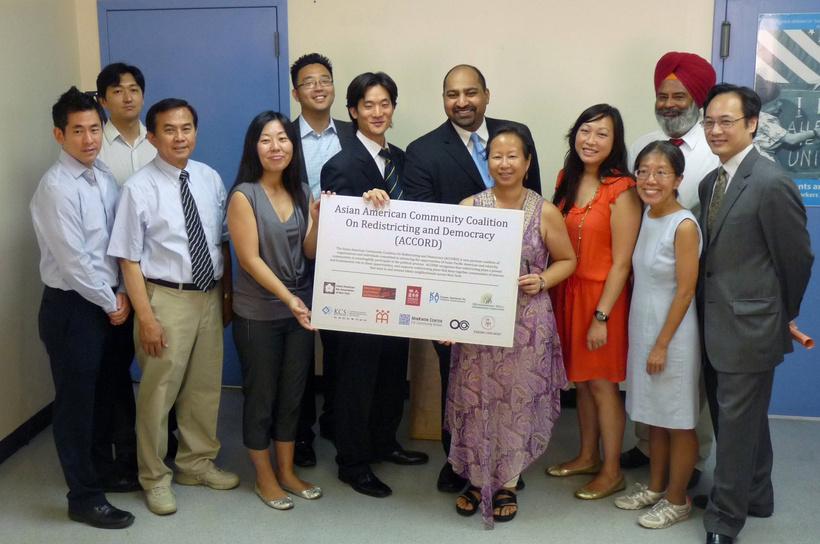

200,000 voters contacted each year
$500,000+ in subgrants allocated
OUR IMPACT AND APPROACH
We are so successful because our organizations work from the grassroots and are deeply embedded in the everyday lives of our community members. APA VOICE empowers the unique perspectives of our organizations with the tools to be leaders within their own communities. At the same time, our strength lies in our ability to bring together stakeholders across our diverse community to speak with a unified voice. Together, we work to raise voter participation among Asian Americans and fight for a more inclusive and representative democracy.
Our model relies on a few key tenets:
Civic Engagement as Immigrant Power: Civic engagement is about building long-term power for immigrant communities. We work with immigrants on every part of their civic journey, from naturalization to getting to the polls to political advocacy.
Language Justice and Cultural Empowerment: In 2023, APA VOICE provided written voter education materials in 9 different languages. Our member organizations conducted their work in over 25 languages.
Canvassing: The most impactful way that we can move people to vote is by meeting them where they are at and building deep, meaningful relationships. In 2023, we trained over 150 community members across 7 organizations to knock over 13,000 doors.
Candidate forums: Our candidate forums are one of the only avenues for everyday Asian New Yorkers to get to know candidates, hold them accountable, and have a voice in government.
Capacity building: MinKwon Center, as the convener, brings over two decades of civic engagement expertise to provide the model, tools, and training to allow organizations to become leaders in their own communities.
Coalition building: Through it all, we find unity in diversity by creating a shared agenda for Asian American civic engagement.

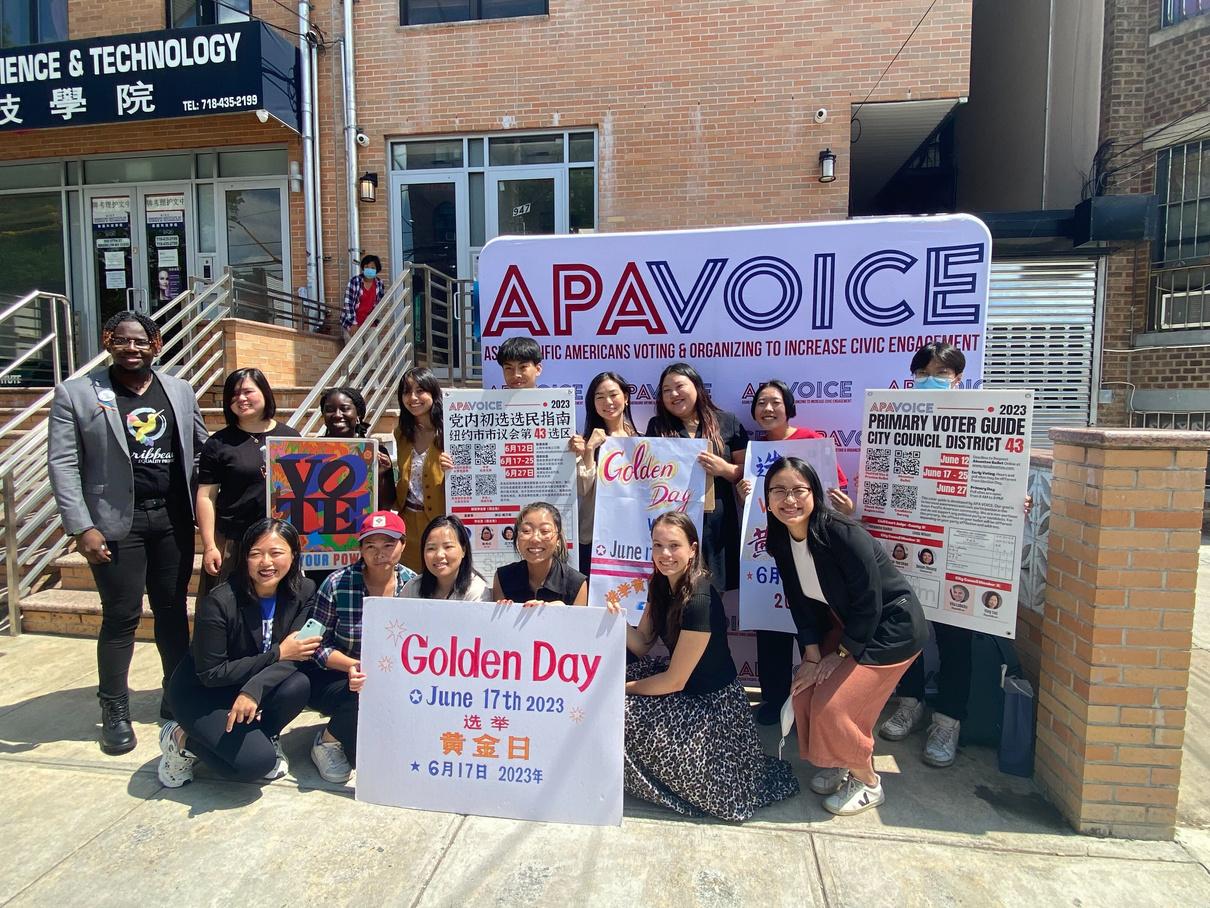
THE GROWING ASIAN-AMERICAN VOTERBASE
Our investigation of state voting data has revealed new trends and shifting needs:
The Asian American registered voter population is growing rapidly across the state, nearly doubling in the past 11 years.
Asian voter participation has remained behind the general population for every presidential year election since 2012. This disparity is exacerbated for young (55%) and low-income (53%) voters. The need is there as the voterbase grows.
Asian registered voters have the lowest rate of party affiliation. 34% of Asian voters are registered as unaffiliated, compared to 24% of the general population.
Asian voters are an incredibly ethnically diverse group, with population shifts occurring within various ethnic groups. Different Asian ethnic communities vote at different rates. We must empower community-based organizations as experts in their own communities.
The Asian American voting population is growing across the state and shifting within NYC. Particularly, we see growing populations in Staten Island, southern Brooklyn, Long Island, and parts of the Hudson Valley.
Please see page 24 for a summary of key facts from our analysis.

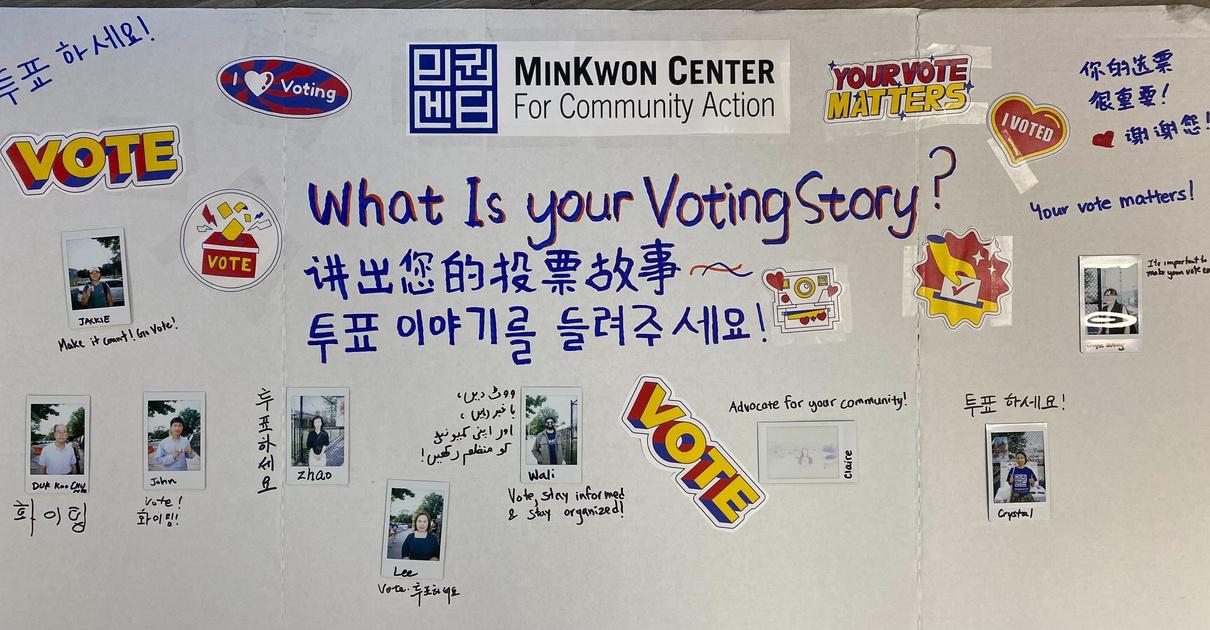
2024 & BEYOND
As our communities adapt and evolve, so will we. With your support, we hope to build out in these areas:
Issue-Centered & Year-Round Civic Education: We must do the year-round work of connecting civic participation to the issues that matter most to our communities.
Deep Canvassing & Canvassing Expansion: Canvassing is by far the most effective, but also the most resource-intensive, form of voter outreach. We plan to expand our training and resource offerings. Specifically, we hope to provide more advanced training around canvasser safety and de-escalation.
Regional Expansion: With shifting populations, we hope to build relationships and strengthen organizations in southern Brooklyn, Staten Island, Long Island, the Hudson Valley and communities upstate.
Youth & Multigenerational Engagement: Young Asian Americans not only are the least likely to vote, but also serve as community navigators for other generations. By empowering our young people, we can empower our broader community.
Accessibility: By building relationships within Asian disability communities and advocating for disability justice in voting, we can safeguard fair representation.
Engaging Ethnic Media & Combatting Disinformation: APA VOICE can serve as a convener and a trusted messenger in the channels that our community members receive their information: ethnic and social media.


We want to make it more fresh and less formal, make it like a party! We want to get the people together, and when we get their attention, we can speak about how important it is to get involved and to vote and become a citizen. Then, they start to feel really motivated. We explain why it is so important with really practical examples– like my landlord, like my citizenship, like government agencies. When we explain it and show them real-world examples of how this works, they tell us, I want to become a US citizen, I want to participate in these elections.”
-Korean-American Family Service Center


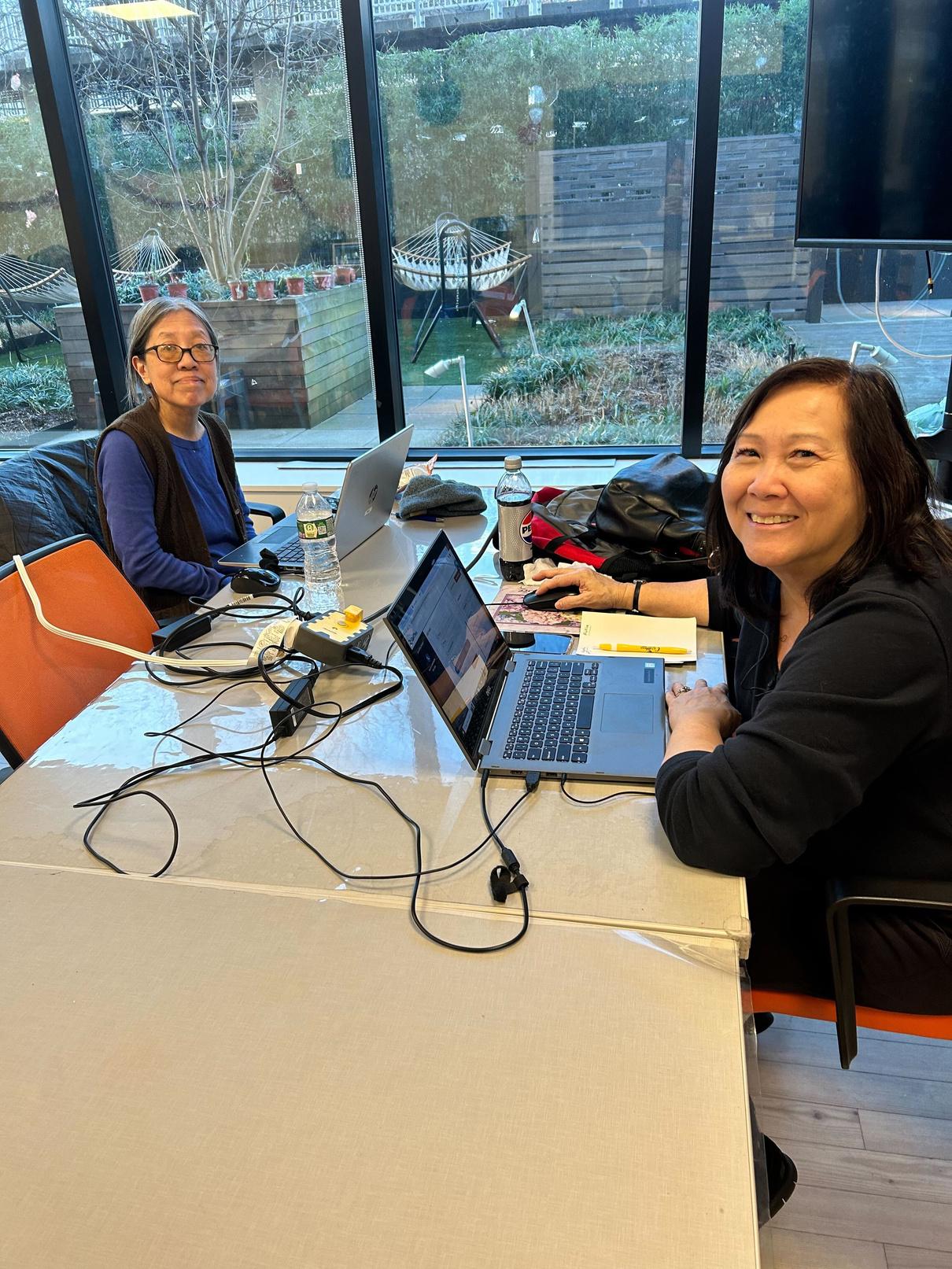
A Decade of Impact: The APA VOICE Legacy

The APA VOICE coalition has established itself as one of the nation’s foremost civic engagement coalitions.
Our advocacy has contributed to the near doubling of Asian American registered voters in the past decade. Since 2014, MinKwon Center for Community Action, the coalition convenor, has raised and provided more than $500,000 in subgrants to more than 35 Asian American community organizations across New York City and New York State
2011
MinKwon establishes the APA VOICE coalition with its first cohort of 14 member organizations.
2014
Asian American registered voters in New York State surpass half a million for the first time ever APA VOICE continues voter registration work
2016
2019
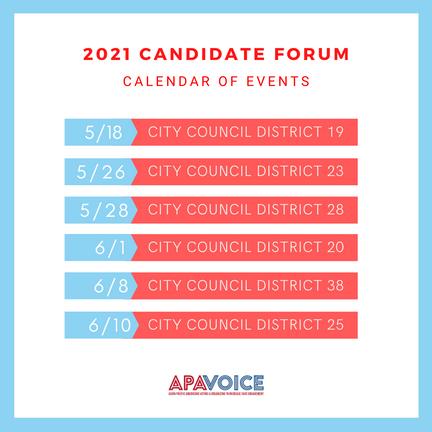

2020
The Asian American Community Coalition on Redistricting and Democracy (ACCORD) is formed, paving the way for APA VOICE
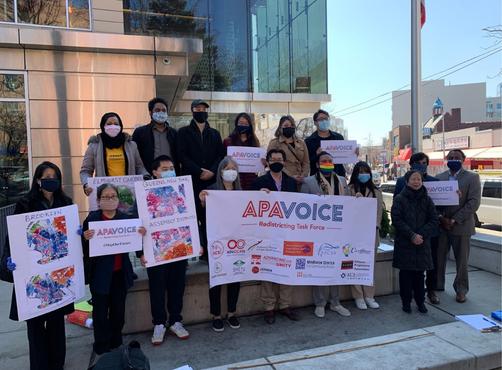
APA VOICE forms the first-ever APA Census Complete Count committee. We Census train 200+ community members
APA VOICE Redistricting Task Force launches with 21 member organizations We successfully advocate for the creation of Asianmajority City Council District 43.
APA VOICE pivots to digital outreach during the pandemic, working to provide our communities with safe and relevant voter education.
NYC sees a pivotal election year with the launch of Ranked Choice Voting and all city council seats open; APA VOICE leads on education Organizes 7 candidate forums across New York
2021
Our City, Our Vote is ratified into law; it is held up in the appellate court where it remains in legislation APA VOICE continues advocacy Collects 1K + pledge cards in support of Immigrant Voting.
The New York Voting Rights Act is signed into law, protecting the rights of communities of color in New York
2022
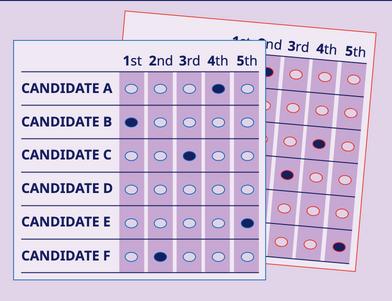
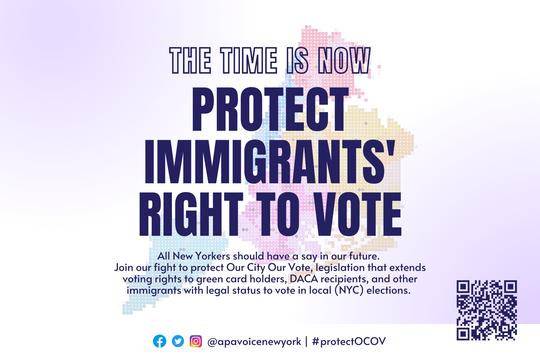
MinKwon Center, the convener of APA VOICE, reaches milestone of registering 90,000+ new immigrant voters.
APA VOICE lays the ground for geographic expansion by covering local races in Nassau County
The first election in the new Asian American majority City Council District 43 in Brooklyn takes place
APA VOICE leads outreach efforts
APA VOICE leads outreach for the Congressional District 3 Special Election in Eastern Queens & Nassau County, the first election of 2024.
2023
APA VOICE relaunches its canvassing program, training 7 organizations to knock on 13,000 doors.
APA VOICE provides $125,000 in subgrants to a cohort of 15 organizations, including new organizations in southern Brooklyn and its first-ever broadcast media member
2024

APA VOICE emerged from the Asian American Community Coalition on Redistricting and Democracy (ACCORD) in 2011 ACCORD's monumental work led to Congressional District 6 becoming an Asian American plurality district This district then elected New York's only Asian American congressional representative. Community leaders involved in the redistricting process recognized the need for a permanent network to sustain the momentum and bolster year-to-year civic engagement The MinKwon Center took the lead in establishing the APA VOICE coalition

“When APA VOICE was formed there was very limited funding in civic engagement, but yet, there were organizations like MinKwon willing to steer it. We see more organizations being brought into the fold because they see that there is a model, an infrastructure, and that they are not walking into this blindly.”
-New York Immigration Coalition
In 2014, APA VOICE launched its first cohort, providing $160,000 worth of subgrants Since the coalition’s founding, MinKwon has awarded and administered over $500,000 in subgrants to coalition members. With two decades of civic engagement experience, MinKwon is a partner to each member organization by:
building the capacity of each organization to lead outreach within its own language and geographic communities providing direct technical assistance on voter engagement tactics
developing messaging
designing and creating original voter education content
translating and distributing voter education content
Most importantly, MinKwon plays a pivotal role by bringing our coalition members together to set unified civic priorities and strategy for New York City’s Asian American communities.

Our coalition continues to grow and strengthen our work. The APA VOICE redistricting task force successfully advocated to preserve and create Asian American communities of interest in New York City during the 2020 redistricting process This included the creation of the new Asian American majority City Council District 43 in Brooklyn. APA VOICE led voter outreach and education efforts in this new district.
The collective advocacy and outreach of APA VOICE over the past decade has catalyzed Asian American civic engagement in New York. This is reflected in the nearly twofold growth of the Asian American voter base, the increase in Asian American representatives on every level of government, and the growing number of community organizations leading civic engagement outreach with APA VOICE resources As we celebrate ten years and build on our successes, we have grown our team, our coalition membership, our geographic scope, and our voter engagement priorities. At the same time, we look to the future by forging new relationships, innovating new strategies, and rising to the new challenges that our communities face
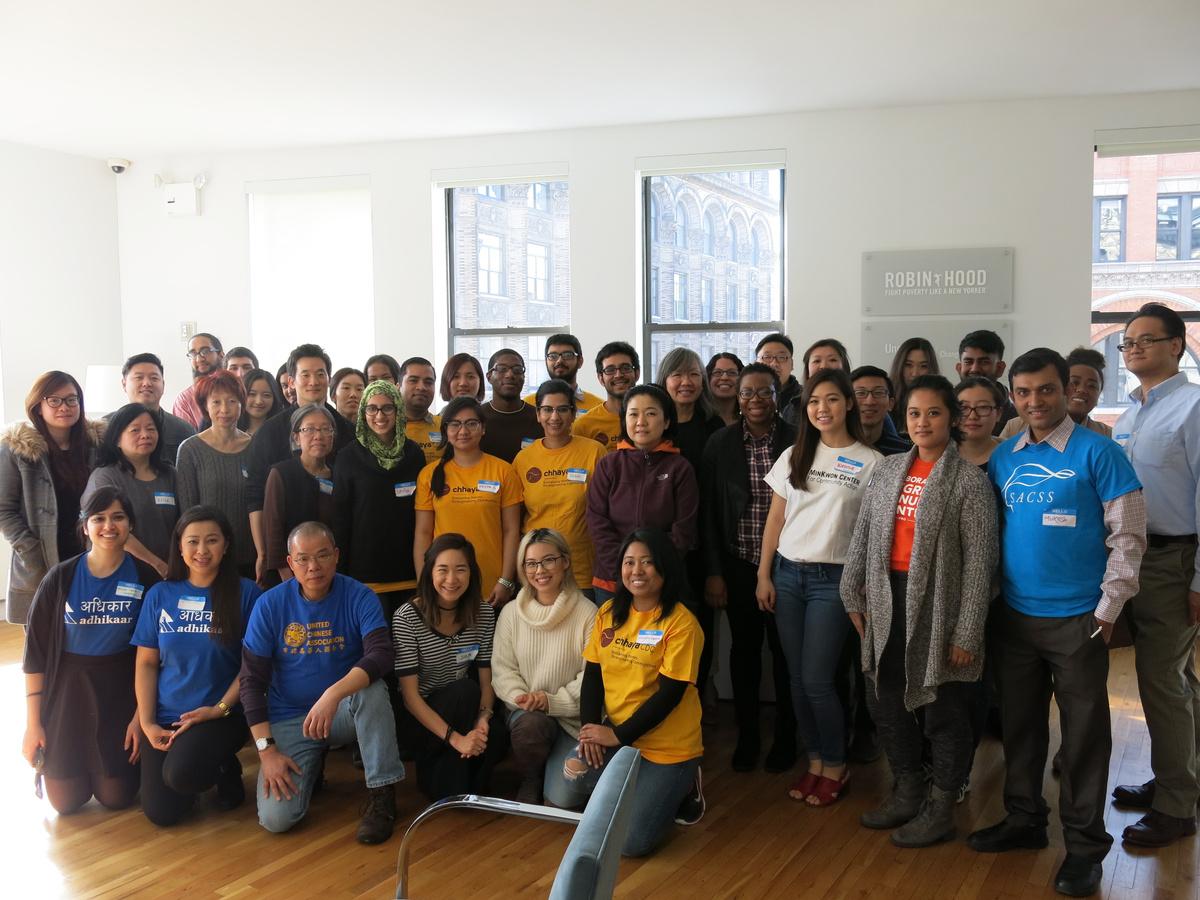


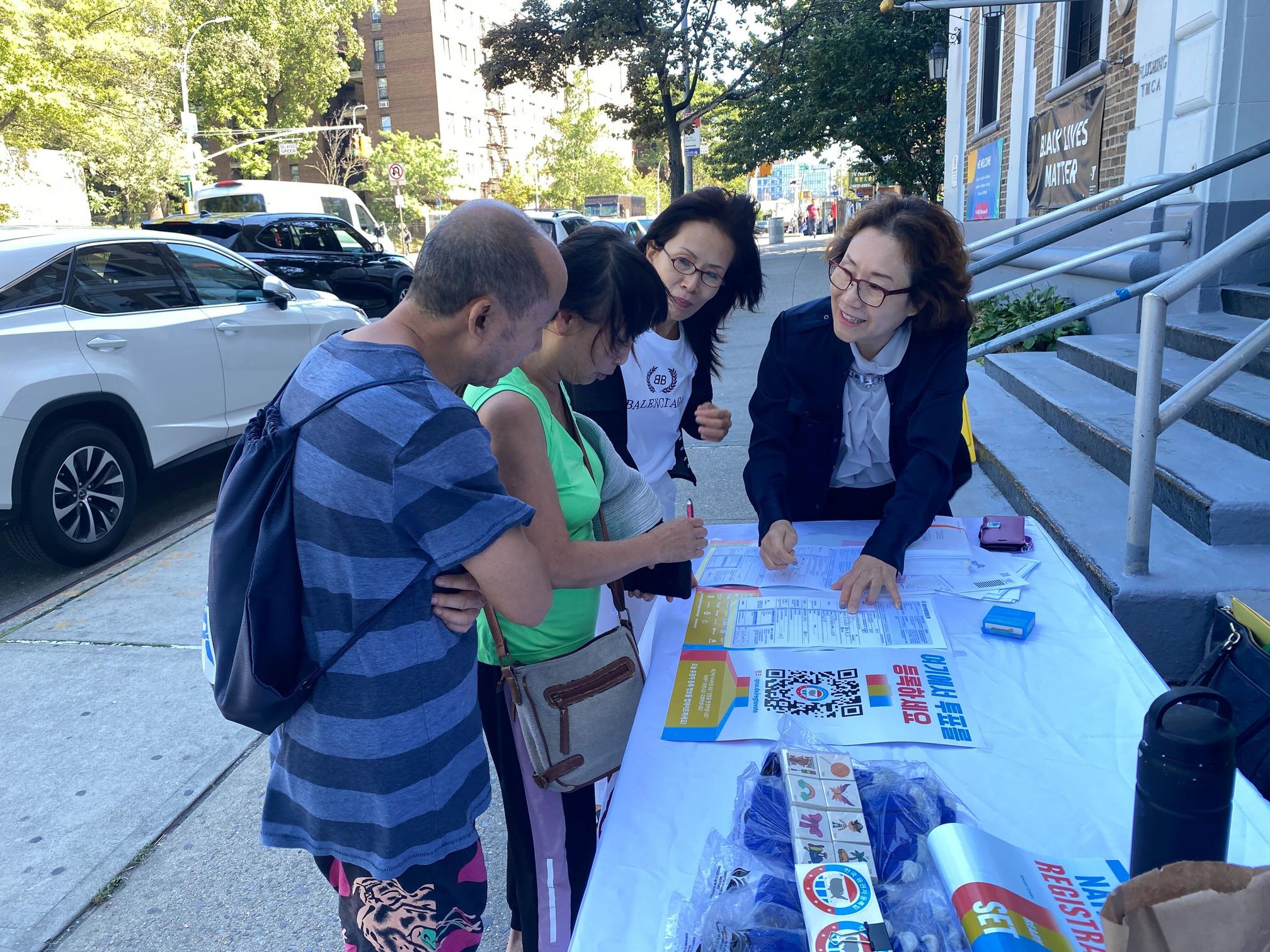
Mobilizing our Communities: The APA VOICE Approach

Throughout our history, the MinKwon Center has been a leading voice in civic participation, working to advance democracy and voting access for Asian Americans As the convener of APA VOICE, we bring this institutional knowledge to our member organizations. As a grassroots organization ourselves, we understand what it takes to build a participatory and inclusive democracy from the ground up.
Through direct service, advocacy, and cultural programming, APA VOICE organizations learn and grow alongside our communities Our coalition has directly facilitated more than 200,000 voter contacts on an annual basis. We have organized highly-attended and impactful civic participation activities, including Census outreach workshops, borough and citywide candidate forums, multilingual voter education drives, voter pledges, and exit polling initiatives. In 2023, APA VOICE committed $125,000 in subgrants for door canvassing and digital outreach to 15 organizations This is the largest amount allocated in the history of the coalition.
2023 GOTV Snapshot
425,283 voter contact attempts
69% of voters attempted were low-income
13,182 doors knocked
150+
trained to canvass
No other civic coalition in New York State matches the depth and range of the voter education and mobilization led by our members. Our greatest strength lies in our ability to bring the unique, community-specific expertise of our members together to speak with one unified voice Together, we build a path forward, formulating a shared agenda for civic engagement in New York City.

Civic Engagement as Immigrant Power
Civic engagement, for APA VOICE, is about building long-term power for immigrant and Asian American communities. Our organizations are deeply embedded in the everyday lives of their community members. Whether the issue is housing, healthcare, or education, community groups know that it takes political power and civic representation to get their communities the resources they need
As a predominantly first- and secondgeneration immigrant community, many Asian New Yorkers are not citizens and don't have the right to vote. In fact, less than half (42%) of the Asian Voting Age Population in New York City is represented politically through voter registration. This makes voter mobilization among those who are eligible to vote especially crucial. Even among citizens who are registered voters, Asian Americans face additional barriers, including language access, institutional mistrust, intergenerational gaps, and a lack of access to civic education. Much of our community lives in survival mode, unable to imagine the broader horizon of civic empowerment.
“Civic engagement is an important part of empowering our community members to make their voices heard, to choose representatives who have their best interests at heart, and to build political power for immigrants, for Asians, and for low-income New Yorkers. Our civic engagement work has been about trying to engage these groups that have traditionally been left out of the political process so that they can address the systemic problems that are challenging their families and their communities.”
-Chinese-American Planning Council

APA VOICE works to bring our communities beyond survival and into a space of empowerment, resilience, and progress This work goes beyond just voting; we are there for every part of an immigrant's civic journey, from providing naturalization resources to civic education to ultimately getting people to the polls. Through it all, our coalition members work to build, protect, and mobilize the Asian American voter base each year. We do this work so our communities can advocate for their right to live, work, build families in all forms, and participate in civic life freely


“For immigrants, if they have a personal connection to either the issue or the people who they are talking to, then they will respond to it. For us, in Chinese culture, the 'who' is very important. So this on-the-ground, person-to-person work is really important and we should be doing more of it. We are a neighborhood organization and when people know us and trust us, it is much more comfortable than someone from the outside coming in and talking to them.”
-Chinese Progressive Association

Language Justice and Cultural Empowerment
Asian Americans face distinct forms of disenfranchisement through language injustice and other forms of cultural alienation. APA VOICE directly intervenes. By building deep relationships and using culturally relevant and empowering messaging, we meet our community members where they are at and bring them forward with us
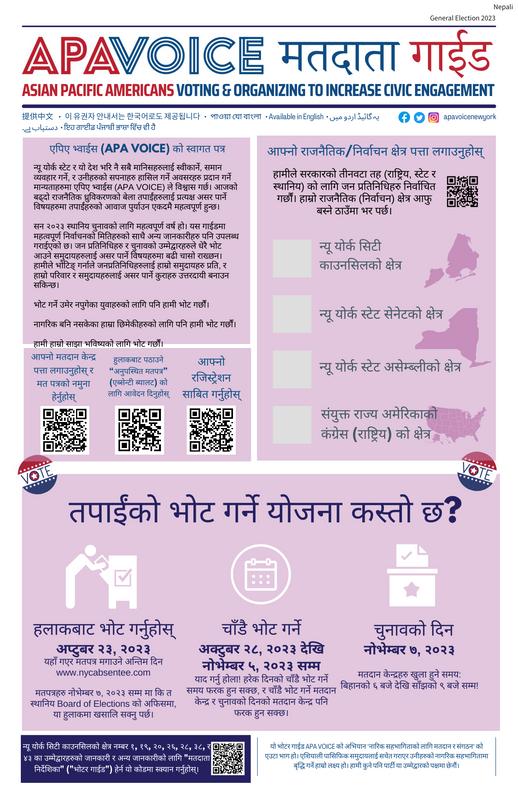
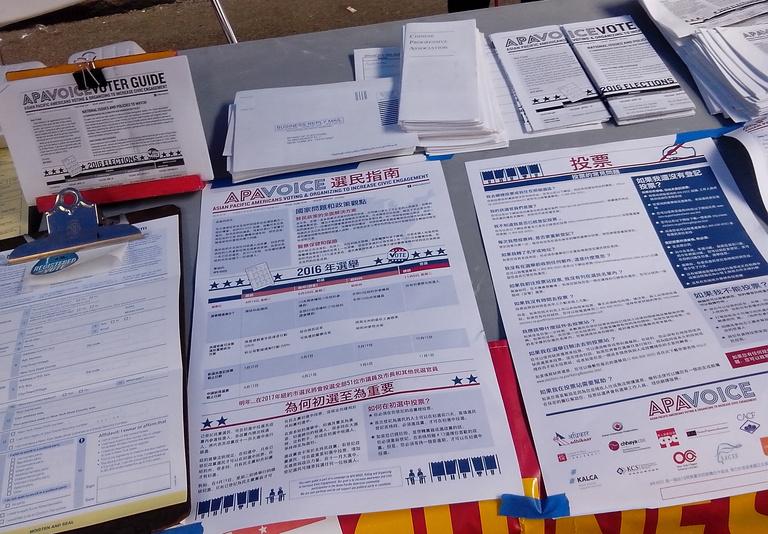

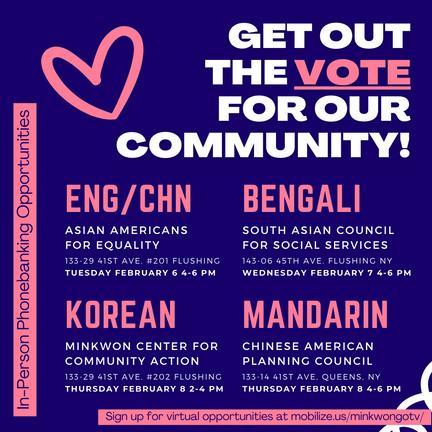
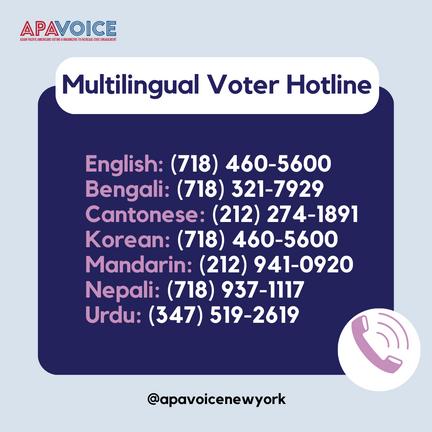
“One of the biggest places that APA VOICE has been able to support us is by getting the cultural competence, but also the language justice, aspect of making sure that voter education is accessible to members in any language. By getting translated materials and making sure we have an interpreter if we are doing forums, we ensure that our members understand. Without APA VOICE, we wouldn't be where we are today in terms of being able to do independent GOTV work.”
-Adhikaar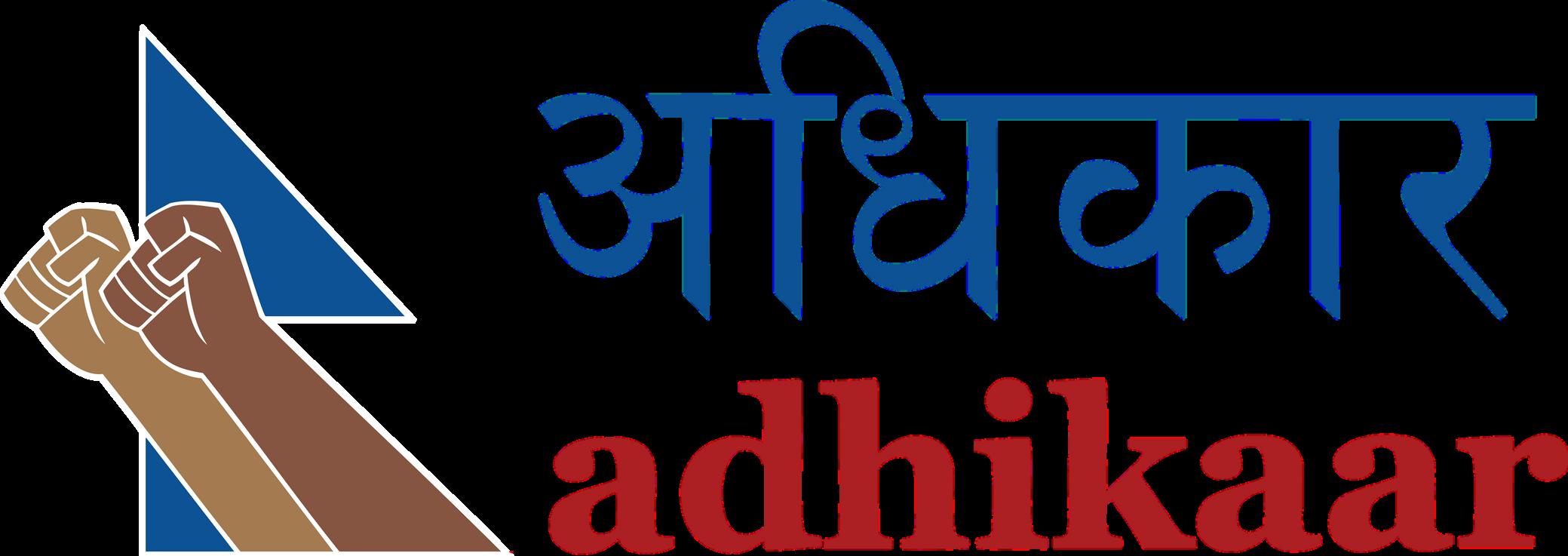
Language justice is key to empowering our communities to vote In 2023, APA VOICE provided written voter education materials in 9 different languages Our member organizations conducted their work in over 25 languages. We provide interpretation across our candidate forums, conduct multilingual training for our organizations, organize in-language community outreach, and operate a multilingual voter hotline in 7 languages.
Languages spoken by APA VOICE Coalition
Korean
Tagalog
Mandarin
Haitian Creole
Fulani
Punjabi
Hindi
Fujianese
Wolof
Mandingo
American Sign Language
Urdu
Spanish
Cantonese
Nepali
English
Malayalam
French
Faarsi
Malinke
Tibetan
Arabic
Bengali
Hakka
Gujarati
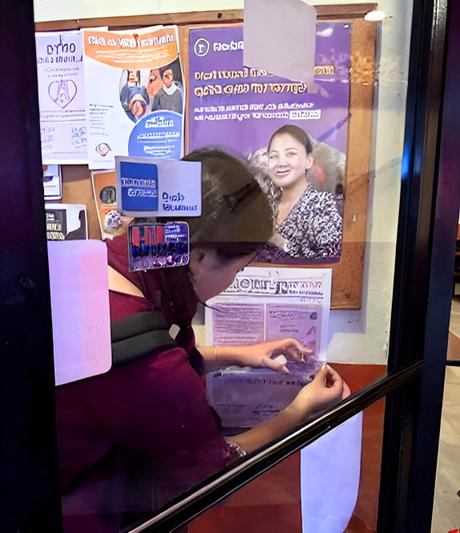

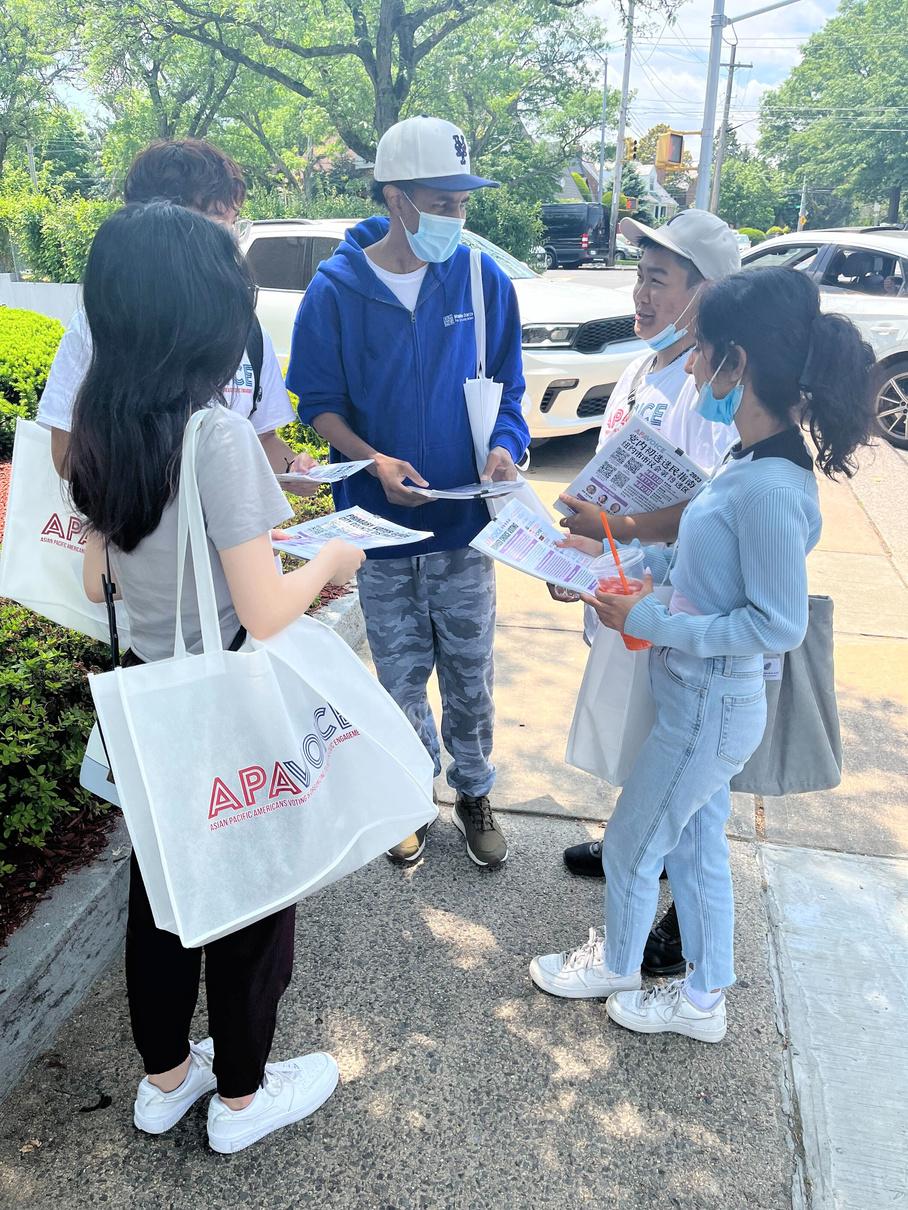
Canvassing
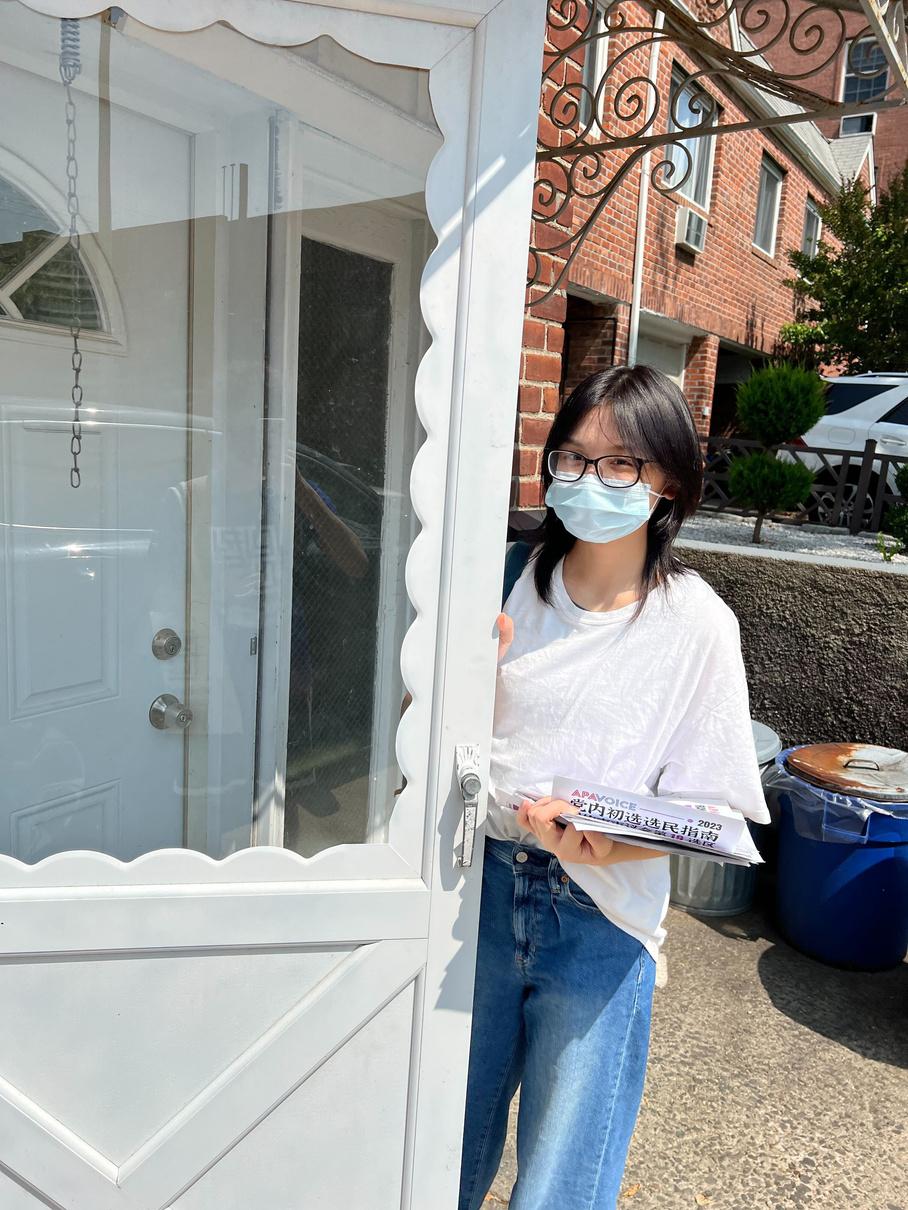
By far, the most effective way to reach our communities is through high quality, in-person conversations This is especially true now In a post-2020 world, people are becoming overloaded with digital messaging and increasingly desire person-to-person interaction In response, APA VOICE has redirected our resources towards funding and training organizations to conduct door canvassing operations.
“APA VOICE really helped us with our June primary canvassing. MinKwon was there every weekend to show us the ropes. I don't think we could be doing the canvass on our own this November if we hadn't had the primaries where MinKwon was leading by example. Having had that experience, we have been able to run the canvassing on our own and cut our own turf.”
-Raising Health

Through door canvassing, our organizations are able to meet our communities where they are and provide them with the support they need to make it to the polls Canvassing has been an integral part of APA VOICE since its founding After a brief pause during the pandemic, it has become even more central to our work
In 2023, APA VOICE expanded its canvassing support and subgranting. We:
Trained 7 organizations to conduct get-out-the-vote door canvassing including 5 organizations who have never canvassed before
Led 6 volunteer canvassing trainings for APA VOICE organizations including 2 multilingual trainings, resulting in over 150 community members trained Trainings were highly multigenerational, including everyone from highschool aged youth to seniors
Knocked on 13,000 doors across eastern Queens, southern Brooklyn, Richmond Hill, and Manhattan Chinatown
Hosted a two-day summit in December 2023 for new and experienced organizers
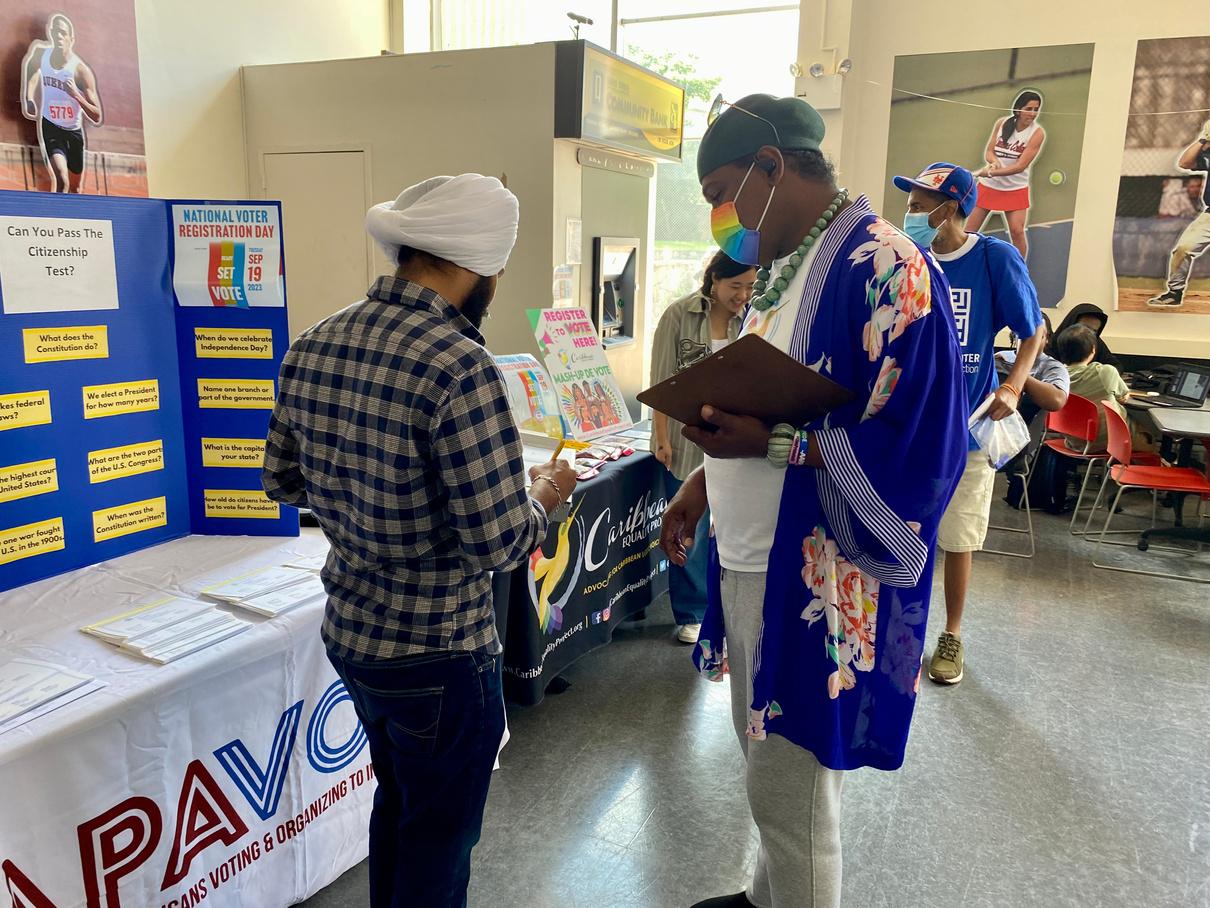

Candidate Forums
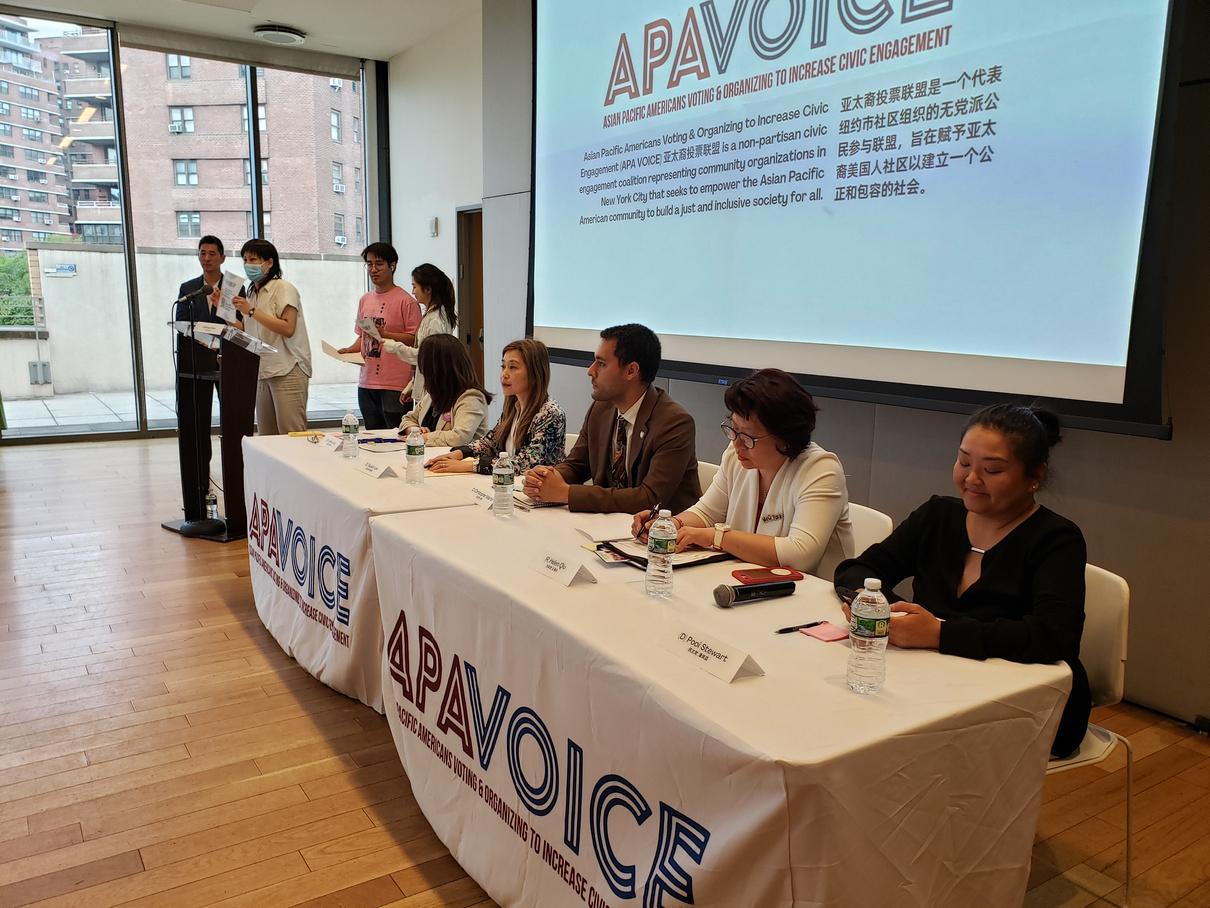
Civic participation for our community is about more than just voting– it is about cultivating a broader voice in government. For many of our community members, APA VOICE candidate forums are one of the only opportunities to directly ask questions of current and potential elected officials. Candidate forums allow our community members to feel empowered, to hold candidates accountable, and to make informed voting decisions. We host candidate forums, conduct candidate surveys on important issues to our community, and produce nonpartisan candidate guides by district in multiple languages. In 2023, we hosted candidate forums in Chinatown and Lower Manhattan, eastern Queens including Bayside and Flushing, and central Queens including Richmond Hill and South Ozone Park.
APA VOICE is unique in our ability to bring together stakeholders from across the city Together, we organize priorities and successfully recruit candidates Because our organizations work from the grassroots, we are able to successfully represent the issues everyday New Yorkers care about. We know that we can't just ask our base to vote– we must tie voting to a greater vision of political participation and power.

Capacity Building and Training Future Leaders
APA VOICE has been essential to the development of the Asian American civic engagement space in New York City We work to build the capacity of our organizations through providing training on all aspects of civic engagement, from canvassing to digital outreach to candidate forums and more By providing a model and building shared institutional knowledge, APA VOICE acts as a leader in this space, empowering organizations to develop strong civic programs from the ground up.
“APA
VOICE was so grounding because there was a community of folks who could really show me the ropes. It was such a great experience to learn from people older than me who've been in this space a long time, people older than me but new to the space, people younger than me but in the space a while, and other folks in the same boat as me. This kind of community is hard to find.”
-Coalition for Asian Children and Families
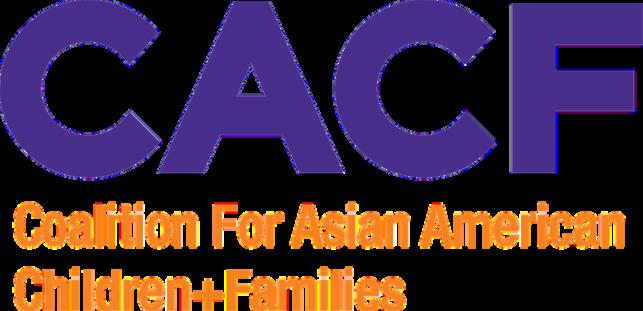

“Anything
we know about getout-the-vote (GOTV) work or canvassing is from APA VOICE. We learned how to do phone banking and door knocking–how to get involved and organize voters– through all of the training and community we've built at APA VOICE.”
-Adhikaar
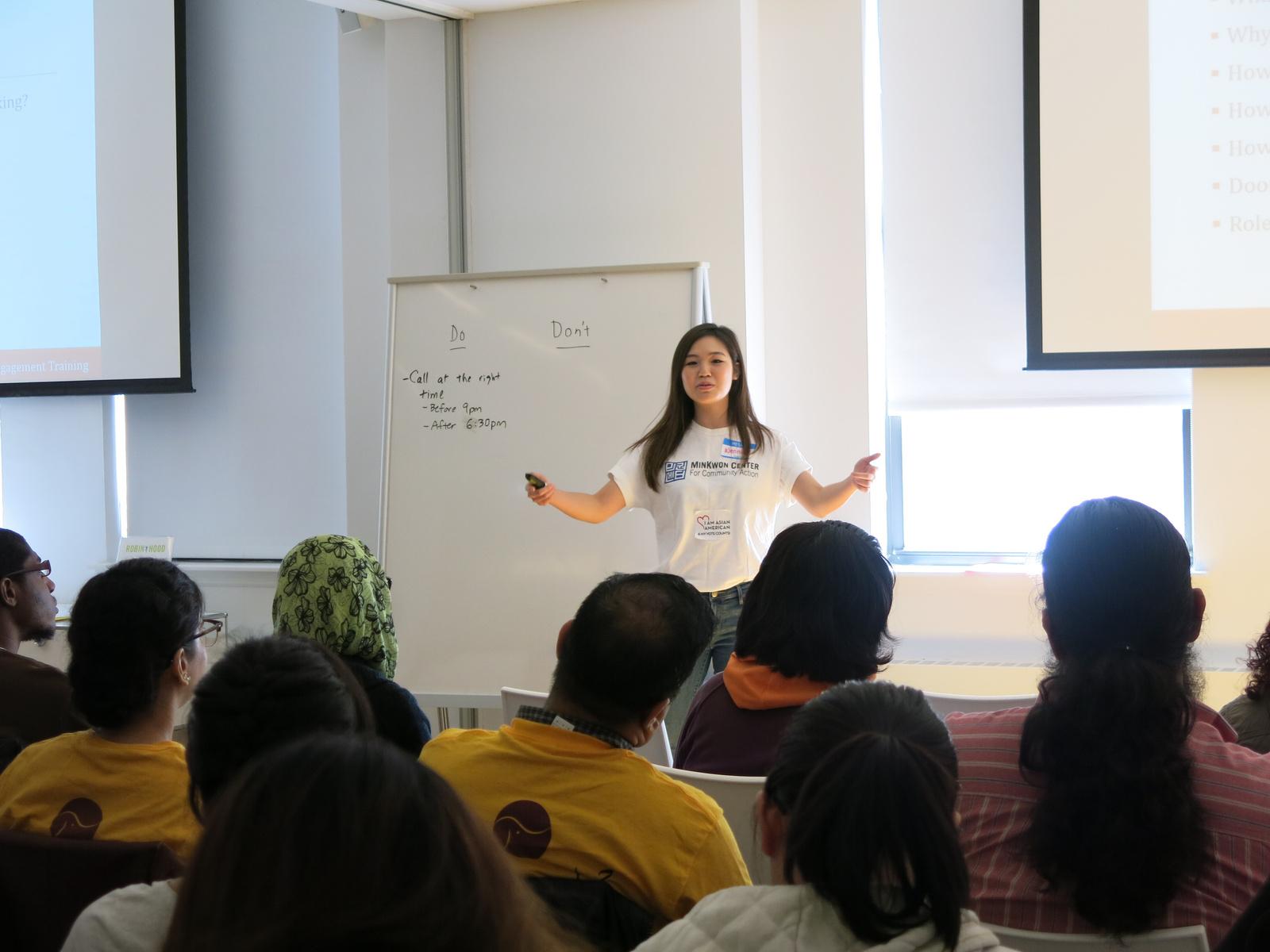

Coalition Building
“Our work wouldn't be possible without MinKwon and APA VOICE. Coalition-building has elevated Caribbean Equality Project's work. Coalition-building also creates an opportunity for diversity. I'm really proud to uplift Indo-Caribbean people within APA VOICE. The resources from APA VOICE have empowered us to activate our community to become more civically engaged. So I think coalition-building is necessary and APA VOICE is setting an unprecedented standard.”
-Caribbean Equality Project
Through it all, what makes the work of APA VOICE so effective is our ability to unite the unique perspectives of our organizations around a shared vision for the Asian American community APA VOICE works as a convener between groups, facilitating shared dialogue, training, and outreach In 2024, our members will act as leaders and further collaboration on borough-wide events, media messaging, youth engagement, and more.

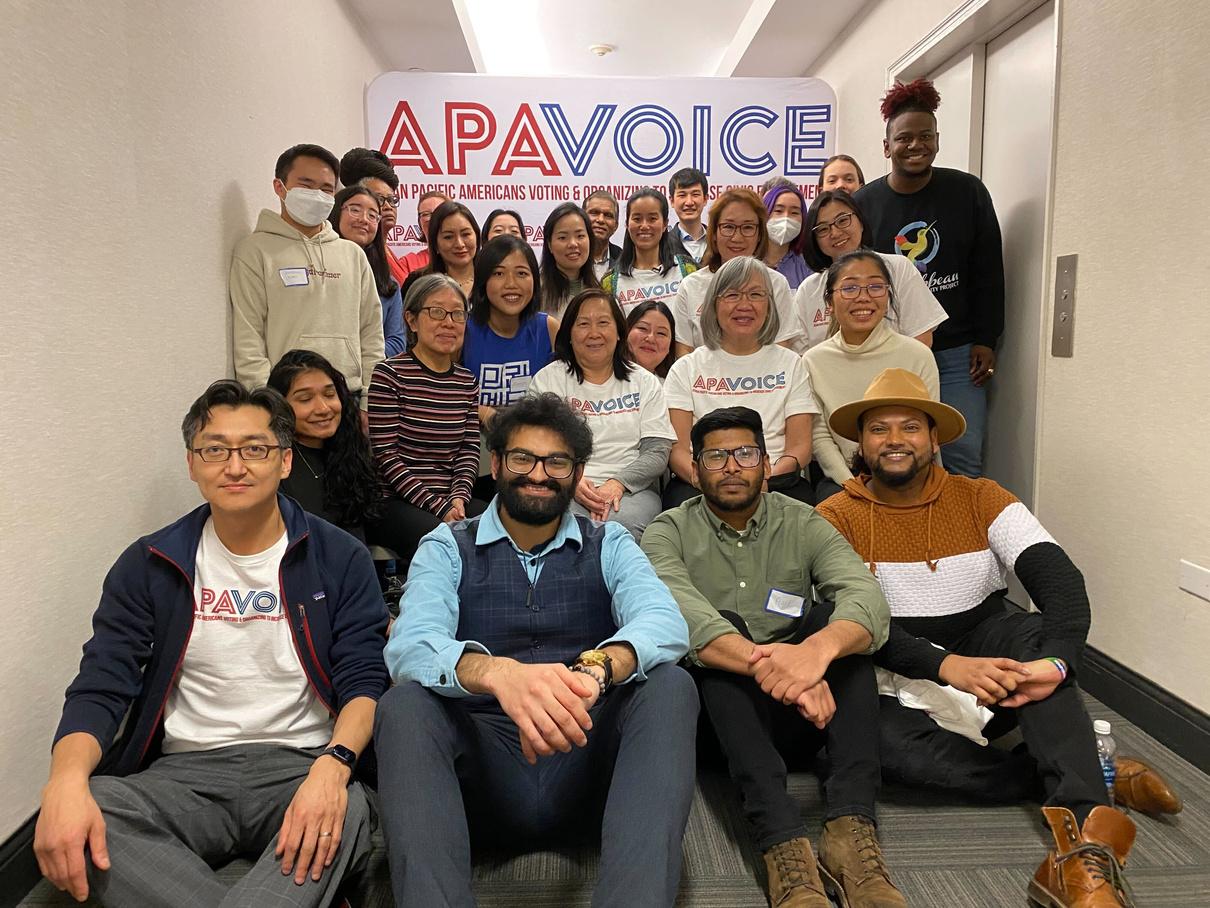

Statewide Data Analysis: The Growing Impact of Asian American Voters in New York
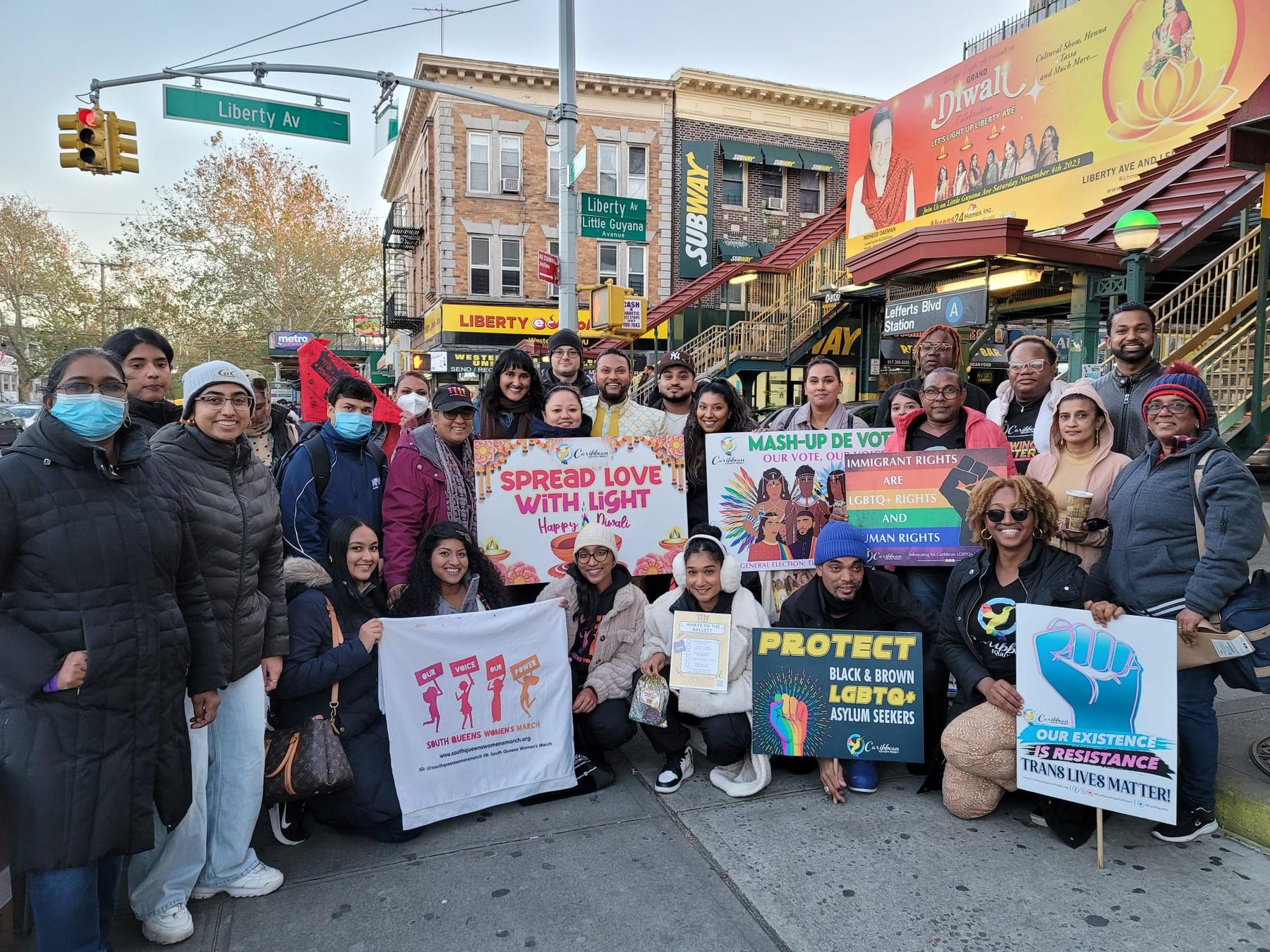

When the APA VOICE coalition came together nearly a decade ago, there were very limited resources and attention given to Asian American communities within the civic space Yet, groups across New York City saw the importance of amplifying Asian American voices in our electoral and political system
Over the past decade, we have seen tremendous growth in the Asian American voting population across New York State, signifying both the efficacy and importance of this work. Yet, Asian voter participation continues to trail behind the general population. This, combined with diversity and demographic shifts within the Asian American community, necessitates further reinvestment into and rethinking of how and where we engage our community in all of its forms
This section investigates data around Asian American registered voters to not only demonstrate the growth and significance of our community, but also the unique challenges that disenfranchise many Asian New Yorkers Our analysis revealed 5 key facts we will explore The data used is drawn from the Catalist voter file data
Key Facts Summary
1.
The Asian American registered voter population is growing rapidly across the state, almost doubling in the past 11 years. This means the Asian voter population has increased at more than twice the rate of the general voter population. The growth demonstrates the impact of our work over the past decade as well as the need for continued reinvestment and innovation
Asian voter participation remained behind the general population for every election year we studied. In the 2020 General Election, Asian American voter participation was at 57% compared to 68% of the general population. This disparity is exacerbated for young (55%) and low-income (53%) voters, and is uneven among different Asian ethnic groups This underscores the continued importance of our work and shows the necessity of increased ethnicity-specific, youth, and low-income outreach
3.
Asian registered voters have the lowest rate of party affiliation. 34% of Asian voters are registered as unaffiliated, compared to 24% of the general population. This means fewer Asian voters are eligible to vote in the primary elections, making primary election outreach more important

2.
Key Facts Summary cont.
3.
4. While the Asian American voting population remains concentrated in New York City, there are growing populations across the state and shifts within NYC. Specifically, Southern Brooklyn and Nassau County are becoming geographical focus points for Asian American voters.
Asian voters are an incredibly ethnically diverse group, with population shifts occurring within various ethnic groups. Different Asian ethnic communities vote at different rates and face different barriers. The most populous Asian ethnic groups among registered voters included Chinese, Indian, Bangladeshi, Korean, and Arab voters. The fastest-growing Asian ethnic groups among registered voters included Arab, Nepalese, Bengali, and Pakistani voters. It is crucial to invest in organizations to conduct outreach within their own communities.
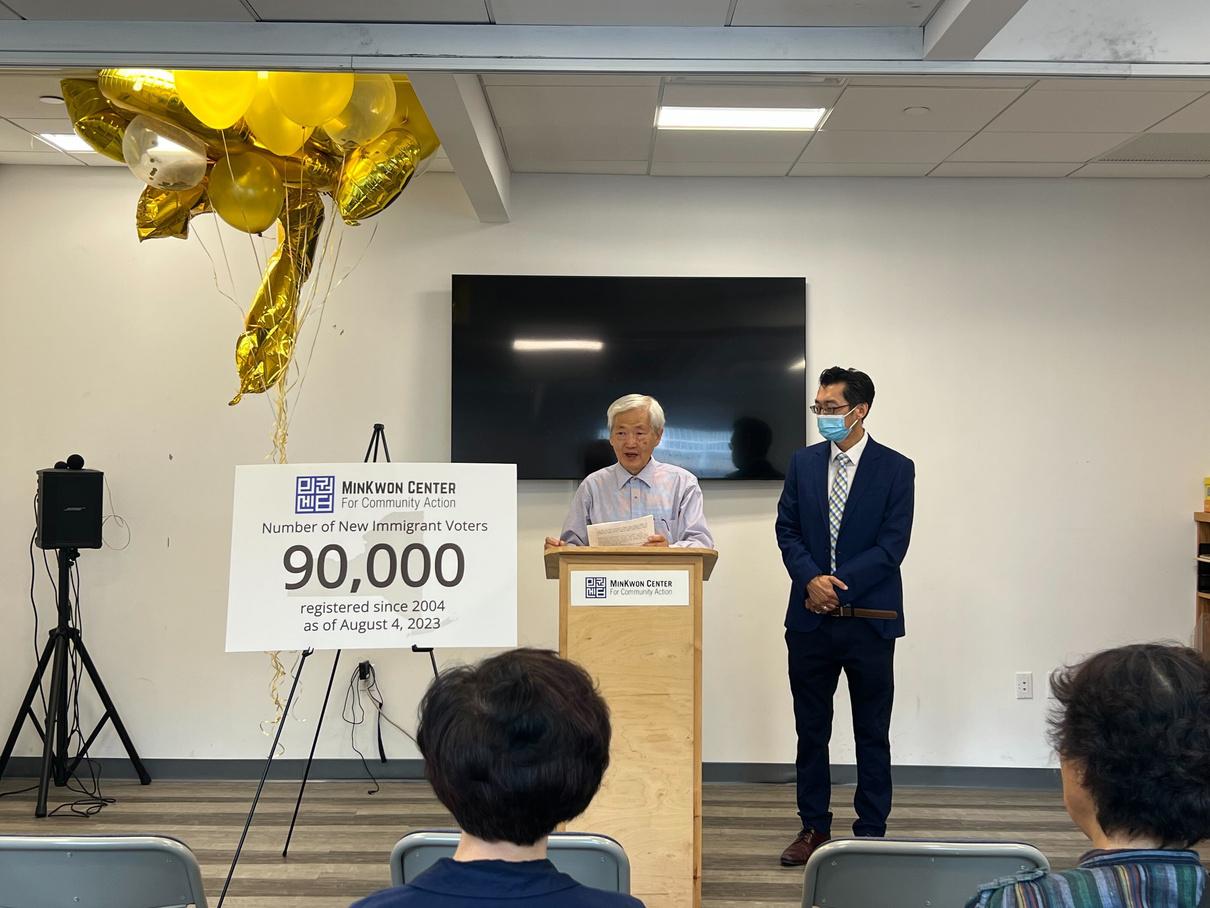

Asian New York at a Glance
2023 Snapshot
New York City vs.
530,541 Asian Registered Voters
10.7% of Registered Voters are Asian
New York City
474,860
Asian Registered Voters
656,050
Asian Citizen Voting Age Population
72%
Asian Registration Rate
1,136,219
Asian Total Voting Age Population
42% of Asian Voting Age Population is represented politically
2020 Snapshot
New York State
737,551
Asian Registered Voters
5.8% of Registered Voters are Asian
New York State vs.
659,564
Asian Registered Voters
914,295
Asian Citizen Voting Age Population
72%
Asian Registration Rate
1,562,776
Asian Total Voting Age Population
42% of Asian Voting Age Population is represented politically

Fact 1. Asian voters in NY nearly doubled from 2012 to 2023.
The population of Asian registered voters almost doubled from 2012 and 2023, from 373,533 to 737,551. This means the Asian voter population has increased at more than twice the rate of the general voter population, which experienced a 48% increase. All but one congressional district experienced an increase in Asian registered voters, with some districts experiencing as much as a 400%+ increase in the Asian voter population This signifies that Asian voters are an increasingly significant group not just in New York City, but across the state.
2012: 270,466
2023: 530,541
 2023: 737, 551
2012: 373,533
Figure 1. Statewide Asian Registered Voters, 2012 vs. 2023
Figure 2. New York City Asian Registered Voters, 2012 vs. 2023
2023: 737, 551
2012: 373,533
Figure 1. Statewide Asian Registered Voters, 2012 vs. 2023
Figure 2. New York City Asian Registered Voters, 2012 vs. 2023
Figure 3. New York State Asian Registered Voters, 2012-2023
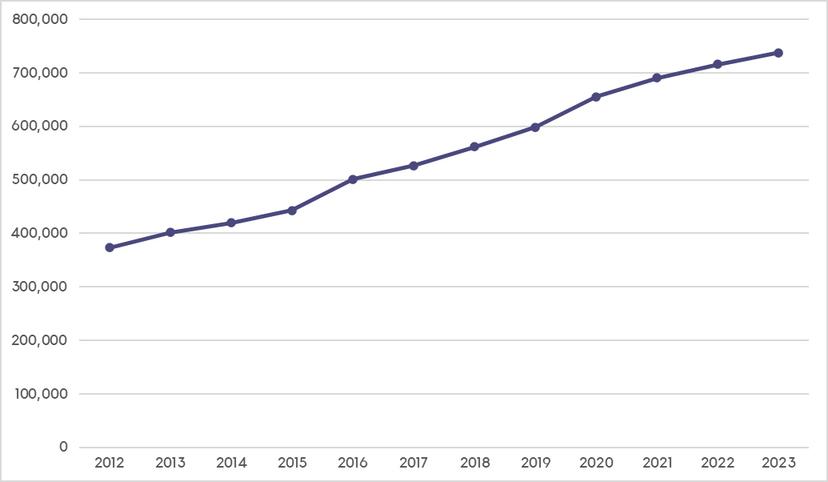
Figure 3 demonstrates that the Asian registered voter population has increased every year in the time period investigated Significantly, the biggest spikes occurred in presidential election years, with 2016 seeing a 58,773 person increase and 2020 seeing a 57,101 person increase. This points to 2024 as a high-opportunity year for voter registration and other forms of civic engagement. It also signifies that the growth in registered voters cannot be simply attributed to population growth An increase in attention and resources during presidential years contributed to registration increases in those years, demonstrating a simple message: concerted voter registration efforts make an impact
The growth of the Asian American voting population in this time period demonstrates the importance and efficacy of the work of APA VOICE. The APA VOICE coalition has been a key player in working to register Asian Americans At the same time, the tremendous growth in Asian registered voters necessitates increased resources to reach our growing community This also means there are many new voters, who are both especially excluded from the voting process and especially opportune for education and empowerment. Overall, the Asian American voting population is growing and becoming a more important political force that deserves the recognition, resources, and education to participate in the electoral process.

Fact 2. Asian American voter participation remains consistently behind the general population.
Asian American voter participation remains behind the general population, regardless of election year or type Like in the general population, voter participation is significantly lower in primary elections than in general elections. This is significant because fewer Asian voters are eligible to vote in the primary in the first place.
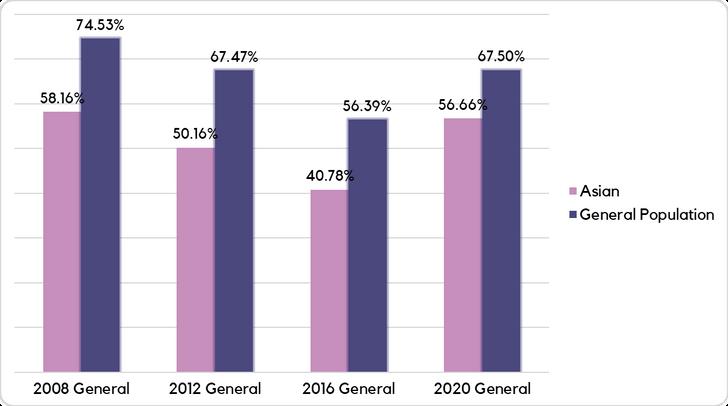
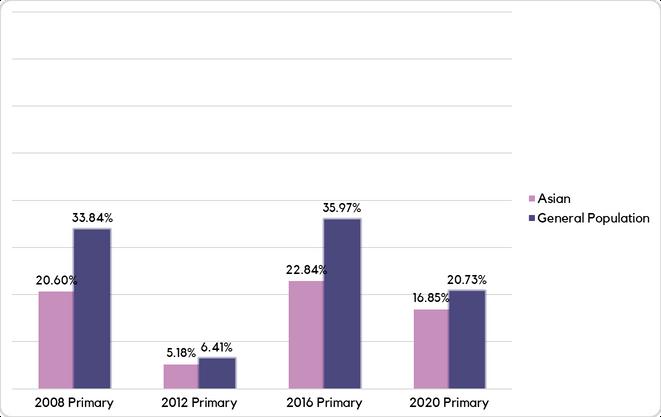
 Figure 5. New York State General Election Voter Participation
Figure 5. New York State General Election Voter Participation
Examining Figure 5, we see both a continued disparity and a sign of hope. The graph demonstrates a “rising tide lifts all boats effect” during presidential years– in high-impact, high-coverage election years when the general population votes at higher percentages, so does the Asian American population The turnout gap is smaller This demonstrates a clear message: if we make it clear to our base how elections can impact their lives, they turn out to vote. It also demonstrates that presidential years are high-opportunity years to close the turnout gap. Looking ahead to the next presidential election in 2024, this data shows hope that continued investment and innovation in voter outreach can make an impact
There are also significant disparities in voter participation within the Asian American community. Looking at the 2020 General Election as a snapshot, overall Asian voter participation was at 57% compared to 68% for the general population. Moreover, when we look closer, we can also see imbalances by ethnic group, age, and income within the Asian population
Figure 7. 2020 General Election: NYS Asian Voter Participation by Age
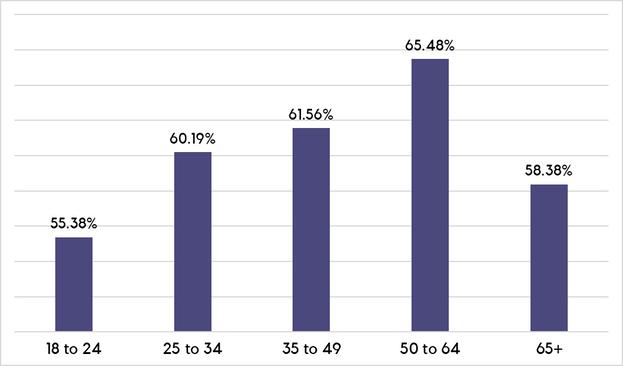
From year to year, young voters are the least likely to vote. This tends to be true across racial and income groups. In the 2020 General Election, 55% of Asian voters between 1824 voted compared to 65% of 50-to-64-year-olds.
However, 2020 also shows a significant departure in one aspect Voters over 65 usually have among the highest voter participation The general population followed this trend in 2020, with the 65+ age group voting at the highest rates (76%) However, this trend did not hold true for Asian voters in 2020, where voters over 65 had the second lowest voter participation rate (58%). It is important to note this is an aberration even for Asian voters.

Still, the 2020 General Election signifies that older Asian voters cannot be taken for granted. In 2020, seniors faced additional barriers with health concerns However, what remains consistent from year to year is that older Asian voters are more likely to face additional access challenges related to language, health and disability, lack of civic education, and technology access.
“When reaching out to the youth, specifically the Asian American community, we see that many are first-generation immigrants or children of first-generation immigrants. These young individuals are often seen as a bridge between generations and cultures. Encouraging the youth to register to vote, we see many just as excited to register their parents to vote. By empowering the youth to participate in the democratic process, we amplify their voices and create a ripple effect that extends to the broader community.”
-Woodside on the Move
Figure 8. 2020 General Election: NYS
Asian Voter Participation by Income
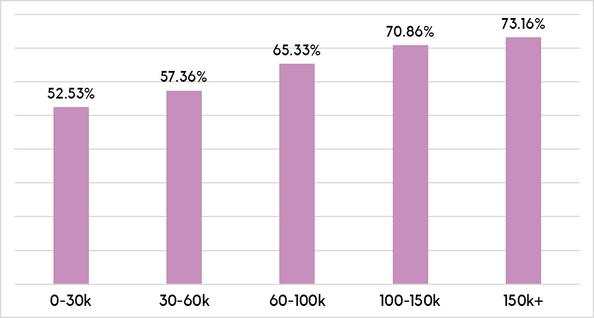
Lower-income Asian voters are less likely to participate in elections, with 53% of Asian voters making below $30,000 participating in the 2020 General Election as compared to 73% of Asian voters who made over $150,000. This amplifies the importance of increasing outreach and engagement among low-income Asian communities.

Figure 9. 2020 General Election: NYS Asian Voter Participation by Ethnicity
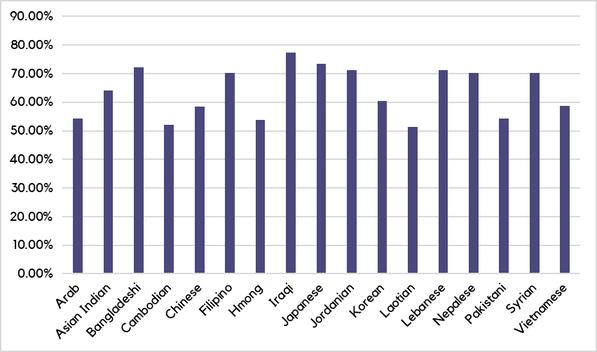
Voter participation varies widely by ethnic community. Of the more populous groups, the ethnic groups with the highest voter participation in the 2020 General Election include Japanese (70%), Bangladeshi (72%), and Filipino (70%) communities and the groups with the lowest voter participation include Arab (54%), Pakistani (54%), and Chinese (59%) communities Among less populous ethnic communities, Cambodian (52%), Hmong (54%), and Laotian (51%) communities had the lowest voter participation rates
Disparities in voting among ethnic groups underscore the importance of targeted outreach, as different ethnic communities face different barriers. Organizations that have strong relationships with local and ethnic communities should be prioritized Continuing to conduct strong in-language outreach is key. Further analysis is necessary to explore voter disenfranchisement for specific ethnic communities
“You have a constant fear of bias and retribution, especially at this time. With crises happening around the world, it's affecting our community at home. You have communities of color and Muslim communities feeling like it may be unsafe to go outside and exercise my constitutional rights. Do I want to go outside and protest? Should I go outside and potentially go against the candidates that everyone is predominantly voting for? Will I be ostracized for it? I think some of these questions are coming up. Can I exercise my rights if I'm different?”
-Muslim Community Network

Fact 3. Asian registered voters have the lowest rate of political party affiliation.
Figure 10. NYS Party Affiliation Rates: Asian vs. General Population
Asian registered voters have the lowest rate of party affiliation out of any racial demographic group 34% of Asian voters are registered as unaffiliated, compared to 24% of the general population This especially impacts primary elections, as this means that fewer Asian voters are eligible to vote in primary elections As a result, APA VOICE requires additional resources to amp up our primary election outreach.
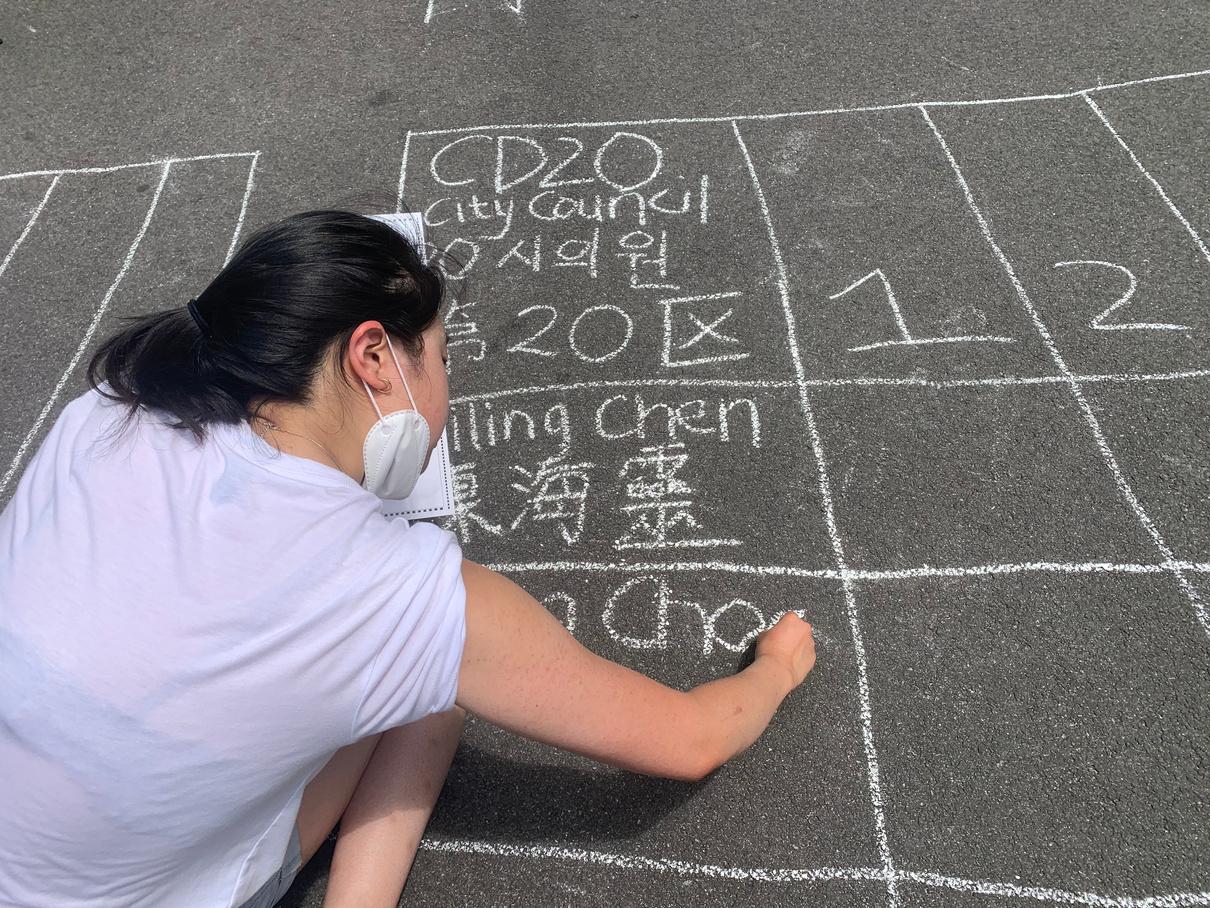

Fact 4. Asian voters represent a diverse array of ethnic communities, each with their own needs.
Asian American voters are not a monolithic group and should not be treated as such Key to APA VOICE’s work is building coalition between organizations while also empowering organizations to serve as voices for their own ethnic and language communities Our organizations work in over 25 languages, mobilizing voters on a neighborhood level to engage the differing needs of our communities.
Fastest growing: Arab, Bangladeshi, Nepalese, and Pakistani Most populous: Chinese, Indian, Bangladeshi, Korean, and Arab
“We are still educating people that we work with on a regular basis on who Indo-Caribbean people are and a lot of that education is now translating to elected officials. When they talk about Asians, and when they talk about South Asians, they should also include IndoCaribbeans. Asians, as a community, we are not a monolith. For many decades we have been generalized.”
-Caribbean Equality Project


Fact 5. Asian voter populations are growing and shifting across the state.
Asian American voters are a large and growing group not just in New York City, but across the state All but one congressional district experienced a growth in Asian registered voters between 2012 and 2023, as illustrated in Figure 12 This shows the increasing impact of Asian voters in virtually every part of the state. This includes districts where Asian Americans have previously been discounted as well as increasingly significant and competitive districts.
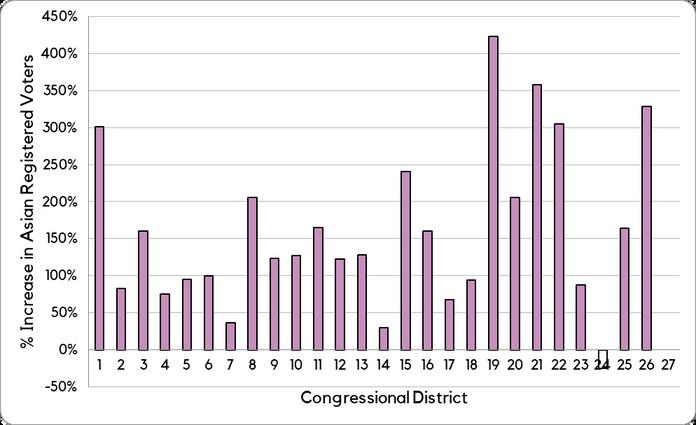

As demonstrated by Figure 13 and 14, the majority of the Asian voting population continues to preside in New York City, where APA VOICE has concentrated its work over the past decade. However, there have been shifts within New York City as well as outside of it. Within New York City, southern Brooklyn and Staten Island have seen increasing Asian populations, with Congressional District 11 having both a high overall Asian voting population and a high growth in Asian voters This aligns with APA VOICE’s increasing focus on southern Brooklyn with new Brooklyn-focused groups in 2023 such as Raising Health and Parent-Child Relationship Association

“The community we serve in southern Brooklyn are immigrants and a lot of them just came to America. Because of the limited English proficiencies of our members, a lot of resources aren't allocated to our districts. It wasn't until we started doing our work that we realized that there is a lack of communication between the community members and government officials. They don't know what our community is lacking. So civic engagement is really important for our organization. If they come out to voice their opinion, vote, and participate, it benefits not just us, but everybody in the community.”
-Parent-ChildRelationship Association

Outside of New York City, we see increasingly significant populations in Long Island and parts of the Hudson Valley and the Capitol District Congressional District 3, containing parts of northern Nassau County and Northeastern Queens, had the second highest overall Asian voting population as well as among the highest growth in Asian voting population. This all signals the potential for more citywide and statewide engagement.
Data Sources
The data in this report comes primarily from Catalist voter file, commercial, and modeled data The only exceptions to this are the Citizen Voting Age Population and Voting Age Population data, which are pulled from 2020 Census and American Community Survey data Data pertaining to the Asian American community may differ in other reports for reasons including the data being pulled at different times, from different sources, or using different statistical models and groupings.
Because voter registration forms do not mandate self-reporting for demographic categories such as race, ethnicity, and income, registered voter data for those categories is based off of Catalist modeling Modeled data uses sophisticated social and data science to estimate what group an individual may belong to. A large portion of our communities are not assigned a modeled ethnicity, meaning that the ethnicity numbers in this report are likely lower than the number of actual voters belonging to that ethnic group. The racial and ethnic group categories in this report are, likewise, determined by the data available to us in Catalist They do not reflect the diversity of how our communities identify themselves


Looking Ahead: the Future of APA VOICE
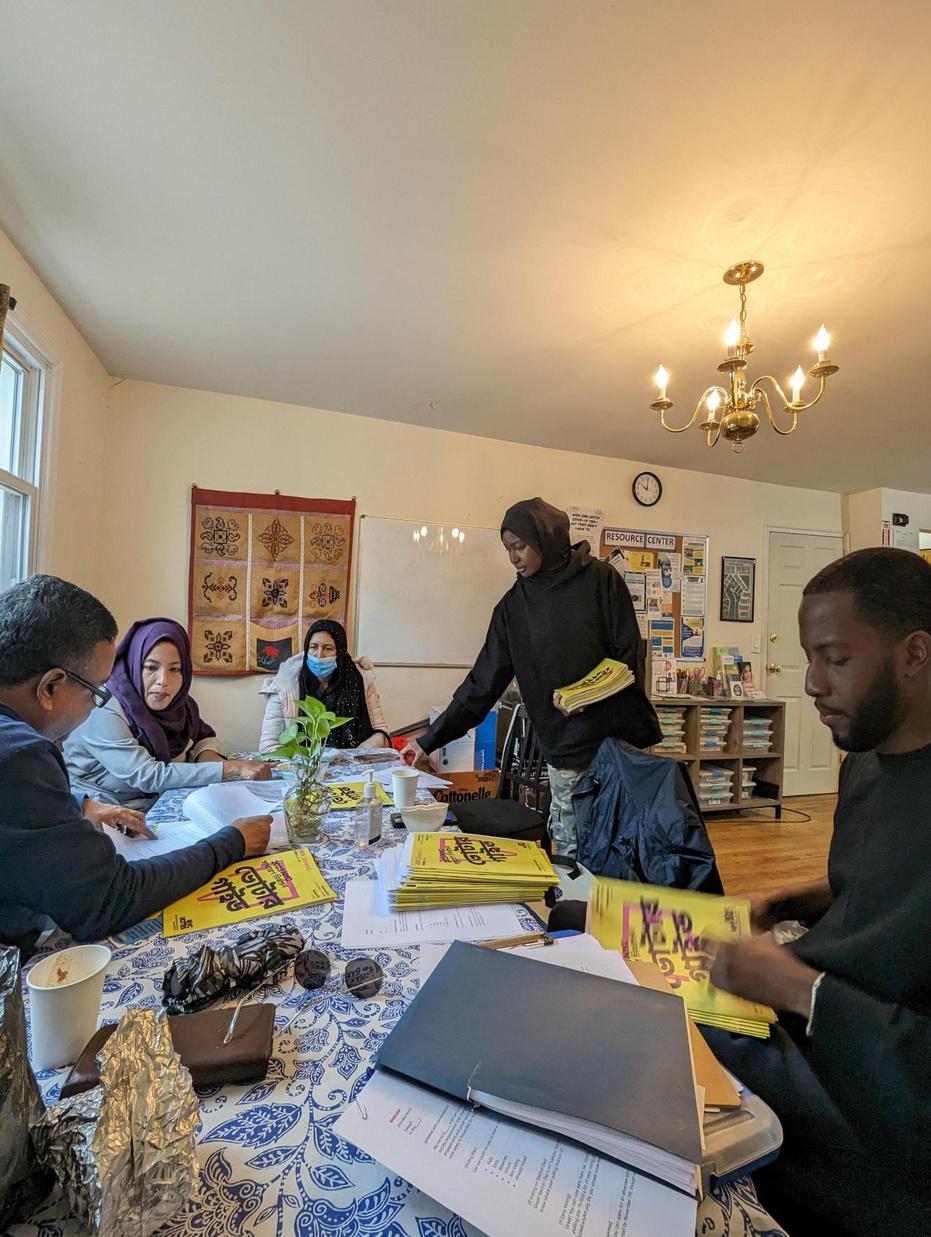

Over the past decade, APA VOICE has been central to the growth and mobilization of the Asian American voter base as well as the development of the leading Asian American civic organizations in New York City By providing organizational capacity-building, technical assistance, and over $500,000 in subgrants, we have empowered over 35 communitybased organizations to reach more than 200,000 voters each year. Our work has contributed to an almost twofold growth in the number of Asian American registered voters in New York.
Yet, we know that the needs of our communities continue to adapt and evolve. While Asian American voter participation has risen, it still remains consistently behind the general population, and this effect is exacerbated for young and low-income voters. As the forces that disenfranchise our community persist, our organizations must also continue to persist, expanding our outreach efforts to center deep, meaningful interactions with voters. At the same time, what our community looks like is changing Growth in Arab, Nepali, Bengali, and Pakistani voter populations indicate the need for APA VOICE to continue building coalition among a wide array of communities As Asian American voters move into Long Island, southern Brooklyn, and Staten Island, there is a need for more investment in Asian American organizations outside of just traditional centers in Lower Manhattan and eastern Queens.
APA VOICE will continue to grow and meet the needs of our communities Our vision of a strong, inclusive democracy for Asian Americans and for all New Yorkers remains unwavering. We will continue to prioritize language justice, high quality voter outreach and education, and organizational leadership development. At the same time, we will also innovate new approaches to meet the needs of our communities. Here are some of the directions APA VOICE may take in 2024 and beyond
Issue-Centered and Year-Round Civic Education
Over the past decade, Asian Americans have seen an increase in political participation However, without the political education to understand how issues intersect with voting, many still do not see the importance. Similarly, without year-round civic education, many do not understand how their votes fit into the larger role of government outside of the election cycle We cannot just ask our community members to vote– we must give them a reason to Nonpartisan political education on a year-round basis would allow our communities to fully participate in all parts of the civic process, and to vote according to the issues that affect their everyday lives.

With increased resources, APA VOICE could build the capacity of organizations to do this work outside of just election season As our organizations are deeply entrenched in helping community members navigate issues, APA VOICE is best positioned to empower our communities to connect those issues to voting and civic participation.
APA VOICE Organizations
Top Issue Priorities
Elder empowerment
Language justice
Domestic violence
LGBTQ rights
Gender justice
Immigrant rights
Data equity
Economic justice
Accessibility
Air quality
Our City, Our Vote
Workers rights
Housing justice
Youth empowerment
Food justice
Sexual health
Education
Religious diversity
Workforce development
Universal Childcare
Fair Pay for Home Care
Disability justice
Health justice
Community safety
Budget equity
Children & families
Environmental justice
Bias & hate
“A piece that we find vital is this idea of political education as a tool in increasing civic engagement and making it more meaningful. Even if we make it super easy to vote, a lot of people don't know why they should get involved. They don't know anything about the candidates or the issues. A politically educated community can fully fight for and advocate for their own interests.”
-Chinese-American Planning Council

Deep Canvassing & Canvassing Expansion
Among our organizations, the consensus is clear: canvassing is the most powerful way for us to reach our communities. However, it is also by far the most resource-intensive. This effect has been exacerbated by the pandemic, as many organizations are rebuilding their canvassing programs from the ground up We need more resources to provide our organizations the training, technical support, and funding necessary to execute successful canvassing programs.

Alongside that, there is a need to pivot our approach to canvassing Our organizations have seen the importance of deep relationship-building, trusted messengers, and quality conversations Additionally, incorporating issues into our conversations through deep canvassing would allow us to connect to voters through the things that truly matter to them. In 2024, APA VOICE plans on expanding its canvassing efforts and offering comprehensive training on deep canvassing and de-escalation.
“We went to a family where we knocked on the door and the dad wasn't at home, but the daughters who were in college were home. They had never registered to vote so we were able to actually register them on the spot. There were other people in the household that said hey, I'm actually going to apply for my citizenship this year, give me the information. It was a moment where I saw that this is something that's really powerful. But I do think canvassing is one of the more difficult aspects of the work. It requires a lot out of you.”
-Muslim Community Network

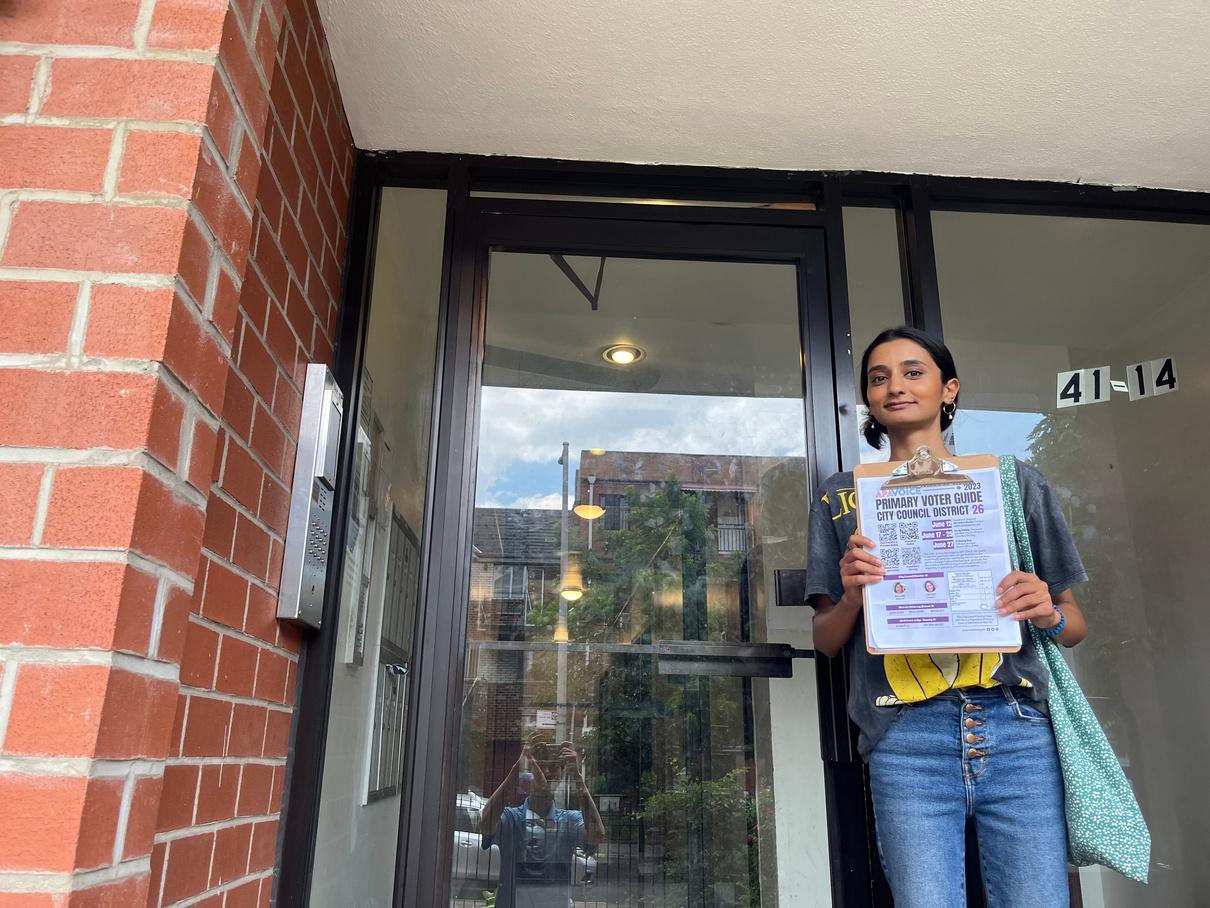

Regional Expansion
APA VOICE has worked to engage Asian American communities across New York City over the past decade, with a special focus on Queens and lower Manhattan However, as the geography of our communities shift, we must also forge new relationships across regions. As discussed earlier, we see growing populations of Asian voters in southern Brooklyn, Staten Island, and Long Island. In 2023, with the creation of the new majorityAsian City Council District 43, APA VOICE expanded our work in Southern Brooklyn. We recruited new organizations and re-engaged existing organizations in the area, including Parent-Child Relationship Association, Raising Health, and Chinese-American Planning Council We also launched canvassing programs in the area, knocking 4495 doors
“The needs that we see in Long Island are very similar to the communities in New York City. Clients need help applying for citizenship and registering to vote. But there are very few Asian organizations working in Nassau County. There are very few organizations in Long Island that provide information in the language the clients speak. It's very difficult for the local community to engage with the county because they don't speak the language and the resources are lacking.”
-South Asian Council for Social Services

In 2024 and beyond, we will continue to support our organizations in southern Brooklyn. With increased resources, we could also explore opportunities to also expand our work in Staten Island and Long Island Staten Island and Long Island have seen increasing populations of Asian Americans Some of our organizations, like South Asian Council for Social Services, have already started to meet the needs in these areas With increased funding, we would be able to better support the work of our existing organizations in the region as well as build new relationships.

“These concepts can be harder to grasp for immigrant and Asian American families. We wa to approach it from an intergenerational lens where we are enriching k so that they can enrich th parents as well. Having these topics brought up the household in general really helpful. Sometime the stuff on social media that we read is more digestible for
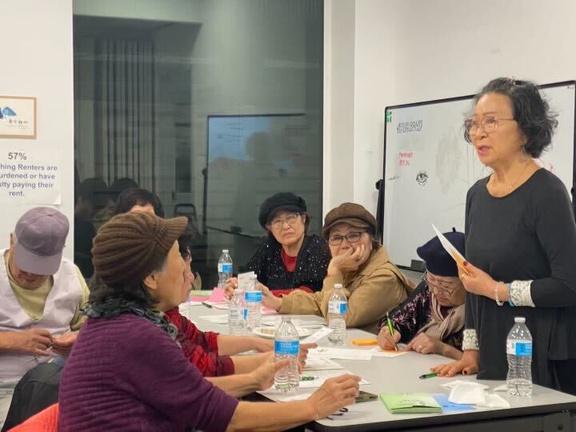
the youth, and so we make sure that they all bring that information back to their parents.”
-Immigrant Social Services

Youth & Multigenerational Engagement
One unique feature of doing this work in Asian American communities is the increased importance of youth and multigenerational work Like in other communities, young Asians are the te. Beyond that, we mmunities face unique Our elders are more ants, to have limited y, and have lower ny older Asian ave grown up in litical participation was en dangerous They uma with them even and becoming
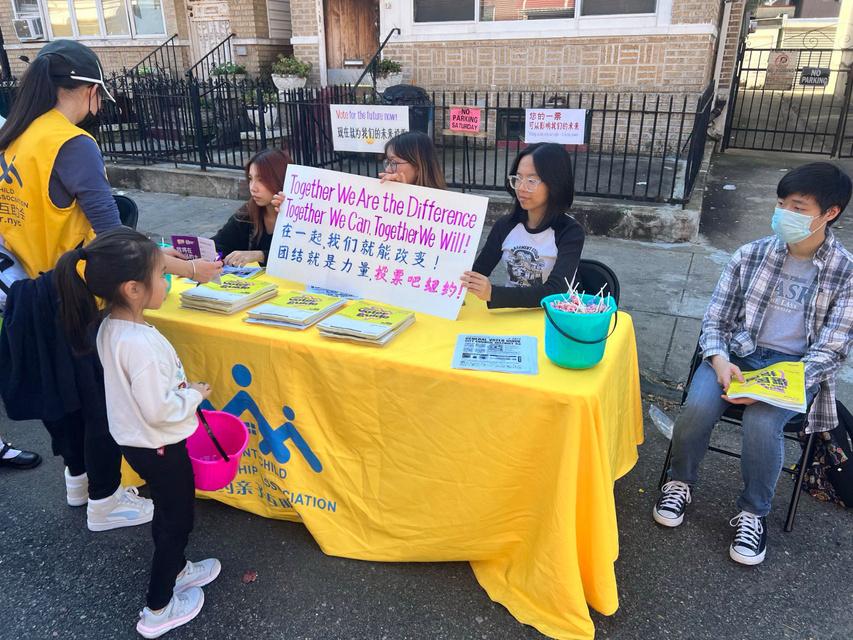
. At the same time, in ican communities, connection is an value Young people are for their elders

Because of this, the importance of youth work in our community is twofold. First, we know that young people face extra barriers to voting They are at a unique crossroads where they often do not have resources to navigate the civic process, yet also tend to respond positively to activation by our organizations Second, in our community, unlocking youth civic participation is an avenue for unlocking participation across generations. Young Asian Americans serve as navigators and translators for their communities, helping their elders access a variety of resources.
Because of this, multigenerational work has always been an important part of APA VOICE’s work In 2023, our canvassers included a high proportion of high school and college students, as well as established adults and seniors. In 2024, we will be expanding our youth work.
Accessibility
Making voting accessible has always been an important part of the APA VOICE ethos We strive to meet our community members where they are and respond to their individual needs. When it comes to civic participation, the Asian American disability community faces unique obstacles. Moving forward, we aim to center disability justice in our work by providing resources to navigate poll site accessibility, advocating for more accessible voting practices, and building deeper relationships within the disability community In 2023, we developed this work by onboarding the Metropolitan Asian Deaf Association as a new partner Together with MADA, we met with the Board of Elections to begin conversations about voting rights and accessibility for the deaf and hard of hearing community.
“Voting is power. It is our voice in government. A lot of deaf people don't know how to vote, so we make sure that they are educated and we help them to vote and speak up and to perform their civic duty. We educate them on their rights.”
-Metropolitan Asian Deaf Association


Engaging Ethnic Media & Combatting Misinformation
In order to provide culturally empowering, relevant education to our community members, we must understand where they get their information. We know that ethnic media sources, as well as social media apps like WhatsApp and WeChat, perform vital functions in our communities Immigrants, especially, rely on these channels to access in-language information that reflects their concerns
APA VOICE is uniquely situated to forge relationships with ethnic media to provide accurate, timely information about voting and government. In 2023, we onboarded our firstever media organization as an APA VOICE partner. Together with Korean Community Media Broadcasting TV, we produced over 14 GOTV videos featuring 15 member organization staff in 8 different languages. In 2024, we plan to expand this work by hosting media roundtables
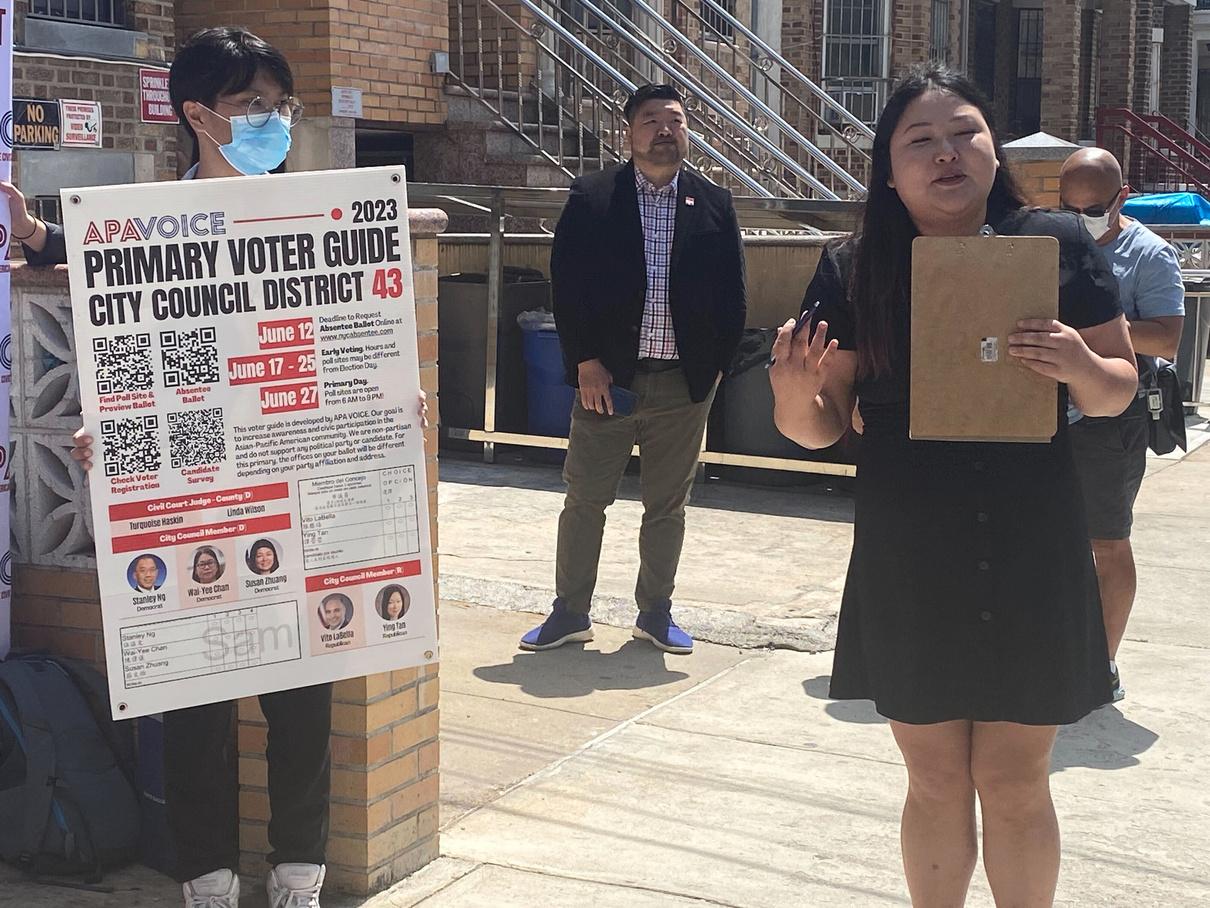

Closing Remarks
Over the past decade, APA VOICE has been able to do remarkable work to build the civic power of Asian American communities The vitality of our coalition lies in the on-the-ground expertise of our member organizations, as well as the dedication of our supporters Our coalition leads on every aspect of civic engagement in New York-- from year-round voter engagement and education, to voter registration, to capacity training, we do what it takes to ensure that Asian New Yorkers are fairly represented. The deep presence our organizations have in the everyday lives of their community members, combined with the shared resources and coalition-building that APA VOICE brings, make our work irreplicable
Ultimately, if our goal is to create a more inclusive democracy and elevate Asian American civic engagement, we must take a long-term view. It is not enough to show up once every ten years for the Census and redistricting cycle We know that we begin the legwork for a fair count by building our base in year-to-year voter education and outreach work Changes in civic culture happen not only on an annual, but also on a generational time scale, and we must invest in our communities for the long haul. APA VOICE will continue to fight for the right of Asian American and immigrant communities to have a say in the decisions that shape our lives. We will adapt and grow, innovating new methods to reach every part of our community We will resist new waves of voter suppression, hate, and discrimination, providing our base with the tools to advocate for themselves and get to the polls And we will do this all together, unifying our diverse communities behind a single voice Your support is key to making this all a reality.

Thank you to our APA VOICE partners!
APA VOICE works formally and informally with nearly every Asian American communitybased organization in New York Below is an appendix of our most active 2023 and 2024 members









